GARNET & BLACK
DON’T YOU, FORGET ABOUT THEM
ADDRESSING THE LACK OF DIVERSITY IN ICONIC FILMS
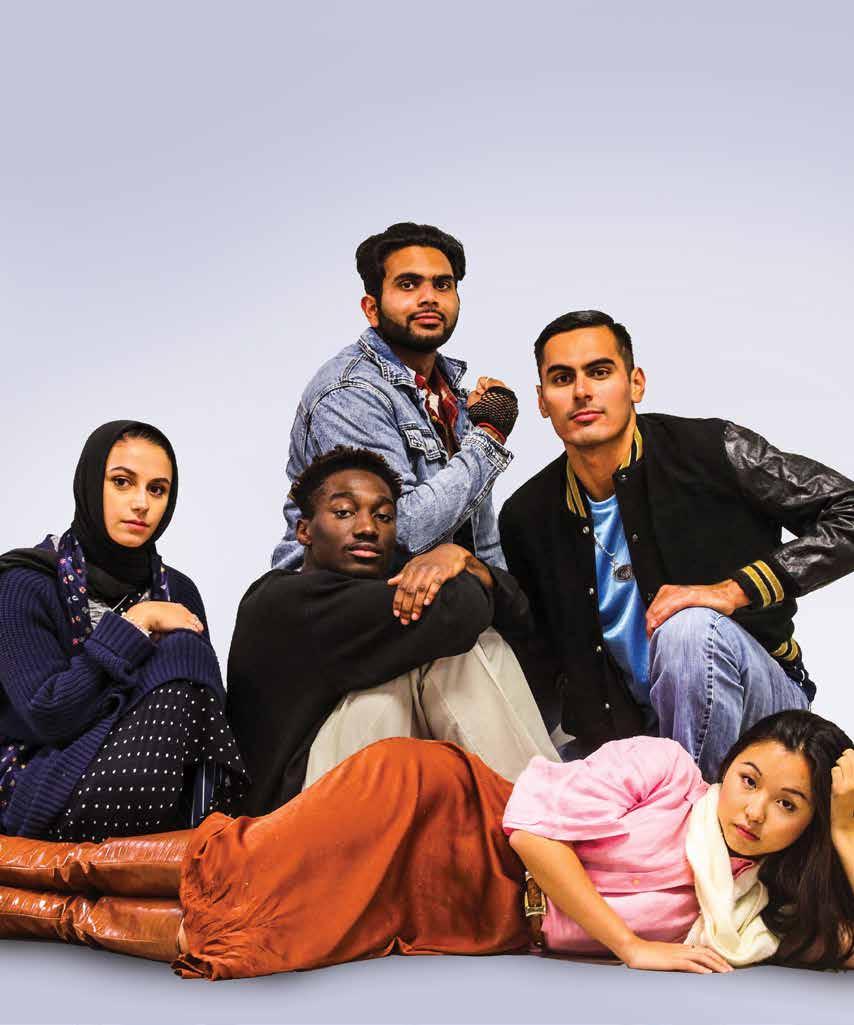
NOT AFRAID TO GO THERE: DRAG QUEEN FASHION THE INSPIRATION BEHIND LOCAL DRAG QUEEN’S ICONIC LOOKS
WHAT DOES GENDER MEAN TO YOU?
STUDENTS PERSPECTIVES ON THEIR IDENTITIES
THE INVISIBLE BEAUTY STANDARD
THE PRESSURE FOR WOMEN TO REMOVE THEIR BODY HAIR IS ANALYZED AND EXPLORED
FALL 2021 STUDENT MAGAZING OF THE UNIVERSITY OF SOUTH CAROLINA
Carolina Food Co. Culinary team!
UofSC has talented chefs who have trained around the world. Get to know them by visiting our locations across campus.
Kyle Hinton, Campus Executive Chef | A native of Charleston, SC, Chef Kyle draws his inspiration from the many flavors native to the southern U.S. He has received recognition locally and nationally for his creativity and attention to detail.



Nathan Whatley, Russell House Executive Chef | Hailing from Columbia, SC, Chef Nathan trained under award-winning chefs in Charleston, SC. He loves all things local and is passionate about keeping artisanal southern food traditions alive.
Robert “Bear” Evans, The Community Table | Chef Bear grew up in the fishing villages and farmland of the Northern Neck of Virginia. He has an appreciation for the rhythms of both city life and sustainable rural communities. Bear has traveled the world pursuing culinary experiences.

George Lamprinakos, Gibbes Court Bistro | Chef George is a Columbia native who learned to love culinary arts while helping his family in the kitchen on holidays. George graduated from UofSC Culinary School and worked at various restaurants in Columbia before joining the Carolina Food Co. team.
Sam Pagan, Bates Diner | Chef Sam trained in the U.S. Navy and continued cooking after his enlistment in restaurants throughout Atlanta. After successfully running his own restaurant for several years, Sam moved to Columbia to work with the homeless population. He recently joined the UofSC team and oversees Bates Diner.
Kyle Smothers, Pastry Chef | Chef Kyle discovered his love of baking while cooking with his mother and siblings. He won a “world’s best chocolate chip cookie” contest and has been featured on Food Network shows as a competitor, champion, and judge.


Liz Sudol, Honeycomb Café | Chef Liz was born and raised in Connecticut, where she graduated top of her class at the Lincoln Culinary Institute. She spent a semester abroad in Savona, Italy before returning to the U.S. for a high-end catering position. In 2017, Chef Liz moved south to join the UofSC team at Honeycomb Café.

ARTICLE EDITORS
WRITERS
STUDENT MAGAZINE OF THE UNIVERSITY OF SOUTH CAROLINA
EDITOR-IN-CHIEF
CREATIVE DIRECTOR MANAGING EDITOR
ENGAGEMENT DIRECTOR
Kendall Vorhis
John Mugabe
Adaija Darby
Ahalya Muraleedharan
Alex Blumenthal
Alex Ruz
Ali Tabassum
Allyson Reavis
Anne McGreevy
Ben Crispin
Brianna Rao
Carson Peaden
Casey McLean
Kelly Hughes
Lauren James
Max Bowman
Reava Bali
Ridha Fatima
Sabrina Artusa
Sam Clarke
Sarah Hudock-Jeffrey
Win Hammond
ALIZAJANE HICKS
SHAIRA NIXON
KEVIN CONNAUGHTON
CLARA BERGESON
SOCIAL MEDIA DIRECTOR
SOCIAL MEDIA MANAGERS
Natalie Hunt
Anna Ottinger
Audrey Leach
Bree Kordes
Jazlyn Gallishaw
Maryah Nasir
PUBLIC RELATIONS DIRECTOR PUBLIC RELATIONS MANAGERS STYLE DIRECTOR STYLISTS
Taylor Richardson
Awani Bildikar
Mayson Beckham
Morgan Pickney
Parker Blackburn
Benji Early
Caroline Callicutt
Cat Harris
Ciara Laney
Chelsea Watson
Dejon Johnson
Dyrek Hamilton
Isha Singh
Joseph Boyd
Kaitlyn Howard
Kat Taylor
COPY CHIEF
COPY EDITORS
Addison Hinkle
Abbie Mott
Abigail Billings
Ariel Meriwether
Kayla DeToma
Lexi Anunson
Lexi Gastelu
Lily Ehemann
Meaghan Knowles
Reagan Green
ART DIRECTOR DESIGNERS
Kendra Wilcher
Lily Miller
Mia McManus
Toni Deloach
Vittoria Gallello
Julia Dunne
Casey Hall
Cecilia Callozzo
Grace Negron
PHOTO EDITORS
PHOTOGRAPHERS
Jensen Bernard
Maria DeSimone
Megan Wooters
Melissa Borgerding
Olivia Son
Savannah Nagy
Aaron Falls
Chloe Caudill
Abby Detorie
Alyssa Bladzik
David Nelson
Dev Patel
Emma Clark
Frederick Gause
Henry Travis
Jackson Tucker
Jacob Garcia Zambrano
Jaylen Anderson
Jerry Bowen
Lexi Croft
Lindsey Hargesheimer
Sydney Bonaparte
Sydney Dunlap
TJ Gibson
Zane Heinlein
ASSISTANT VISUAL EDITOR
Lily VinCola
DIRECTOR OF STUDENT MEDIA
ASSISTANT DIRECTOR OF STUDENT MEDIA
ART DIRECTOR OF STUDENT MEDIA
FACULTY ADVISOR
Sarah Scarborough
Sydney Patterson
Jason Porter
Scott Farrand
Advertising: (803) 777-3018
To contact G&B, email sagandbe@mailbox.sc.edu or visit www.gandbmagazine.com. Garnet & Black Magazine is printed twice a year by students of the University of South Carolina and is distributed for free to members of the university community. All editors can be reached via email on our website. The office is located in Russell House University Union room 339.

Acts of Rebellion
What was your first act of rebellion when you first came to college?
A Yarn-tastic Campus
Find out what everyone on campus is doing and how you can get involved in the action!
The Implict Struggles of Males in Bodybulding and Fitness
A look into the culture behind male bodybuilding, gym culture, and dieting.
Class During Quarantine at UofSC
How quarantined students are being treated as the university transitions to fully in-person classes.
G&B’s Natal Chart
A sneak peak into the personality of this edition.

Rumor Has it: YikYak is the New Gossip Girl
Is the resurgance of YikYak paving the way for a real life gossip girl?
Grasses Flowers, and Plants, Oh My!
Not Afraid to Go There: Drag Queen Fashion
Exploring the inspiration behind a queen’s iconic looks.
Embrace Feeling Uncomfortable
A statement from the editors.
The Rules of a Black Woman
How being a Black woman comes with its own set of regulations for existing.
Defining Courage
Brock Sansbury found strength in recovery and is helping others do the same at the Courage Center.
The Maxcy Stairwell
When reports of sexual abuse go unnoticed by the university, a group of students make sure somebody is listening.
Sex Workers in College
UofSC students are breaking down the stigma around sex work.
What Does Gender Mean to You?
The world is changing it’s attitude around gender.
A deep dive into the local herbarium and it’s curator.
The Invisible Beauty standard
An exploration on women and the pressures they face regarding body hair.
Native Americans are Not Invisible
Native Americans are our neighbors, so why don’t they have access to the same resources?
Women in the Workplace
In a male dominated field, women are taking their own spin on office attire.
Being Black is Punk in Itself
In a movement that has been historically and culturally white washed, Black folk embrace punk and alternative.
Don’t You, Forget About Them
Addressing the lack of diversity in iconic films.
Social Media

See how peopleinteracted with our social media this semester!
Autumn Leaves Falling Down Like Pieces into Place
Check out what the G&B Staff has been listening to.
Overheard at UofSC
Students say the darndest things.
contents
Cover photo by Chloe Caudill Garnet & Black Magazine Fall 2021
F I N D Y O U R H O M E H E R E .
F I N D Y O U R H O M E H E R E .






N O W L E A S I N G N O W L E A S I N G


F A L L 2 0 2 2 F A L L 2 0 2 2














C A L L T O D A Y












2 1 N a t i o n a l G u a r d R d . | L I V E 2 1 O A K S . C O M | ( 8 0 3 ) 9 3 7 - 2 3 5 8
waited my entire life for college. It’s not a place that people from my hometown attend often. It’s not a place that my parents attended.
Growing up, I thought college was this magical land where everyone was suddenly on an even playing field. It didn’t matter that your prom dress was less expensive than all of your friends. It didn’t matter that you couldn’t afford better dance lessons. It didn’t matter if you were queer. I thought college was a place that was big, diverse and filled with educated people – and that made everyone even.
Then I got here.
I quickly realized there would never be such a thing called “even.” Sometimes that one person gets the internship because they know someone who works in the company, sometimes that guy gets away with something bad because his parents have money, sometimes some people get ahead because they were born ahead and that’s how it’s always been.
I’ve thought a lot about privilege this past year. I’ve really had to take a step back and evaluate my own life and how my disadvantages in life do not compare to some other students here at UofSC. We joke a lot about #girlboss culture and how you can build yourself to be someone even if you come from nothing. The so-called “American Dream” of being in a place where anyone can be anything with the right amount of passion.

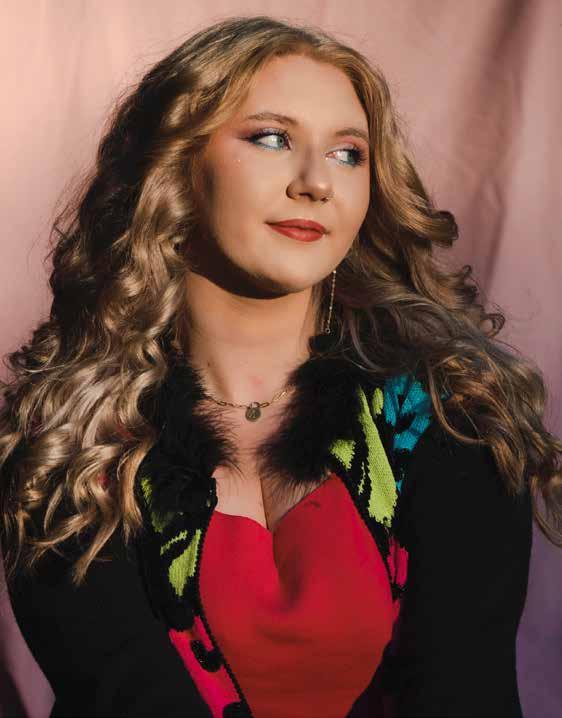
However, that’s simply not true. It takes more than passion to exit the cycle of poverty, or to break down the way our society is built upon the oppression of minorities, or to educate those who are able to help about why they should do so.
When I came to college, I knew I wanted to be someone. I wanted to do something –anything – to maybe prove that “high school me” was right in the way that because I came to college, I can change the world.
I wanted to hear the stories from those who have passion and have a place here in the world despite their lack of privilege. When
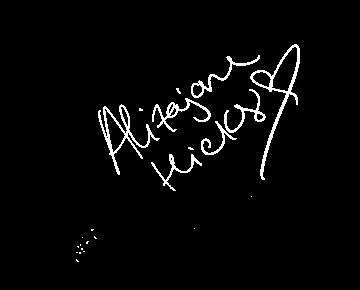
choosing stories for this semester’s print edition, our goal was to have every student here at UofSC see themselves represented on a page. You’ll hear queer stories, Native American stories, Black stories, non-binary stories, stories from survivors and so many more.
Garnet & Black is for you, a tiny sector of this fucked-up world where everyone is even.
Kevin Connaughton
Managing Editor
Beating my frat boy roommate with a book when he took a piss on my textbooks.
Photo Editor Chloe Caudill
The second month of freshman year I dyed my hair pink, got a nose ring, and got two tattoos. I then sent a picture to my dad and changed my phone number immediately after.
Julia
Art Director
I chopped my hair, dyed it, and got bangs. All of which I had wanted to do for a while but felt like I couldn't. I was tied to the expectations of classical dance and my own ideas of myself; finally changing this part of me felt so freeing.
Addison Hinkle
Copy Chief
I stole my dads credit card and sneakily applied to UofSC the night applications were due….Turned out pretty good though!
Shaira Nixon
Creative Director
I stole toilet paper from Russell House and got a bunch of piercings.
Aaron Falls
Photo Editor
Going on a trip to Asheville without telling my parents.
Parker Blackburn
Style Director
I quit my job after a customer looked me in the face and said, "You may be stupid, but at least you're pretty." Now I work for three magazine publications while being a full-time student instead of waitressing.
Natalie
Social Media Director
Not conforming in order to fit in right away.
John Mugabe
Articles Editor
I grew out my natural hair for the first time (and still got a decent o ce job).
Clara Bergeson
Engagement Director
Going on a date with a man right before coming out as a lesbian.
Lily VinCola
Assistant Visual Editor
I got a tattoo after my parents told me they wouldn't financially support me if I got one. They were blu ng.
Taylor Richardson
Public Relations Director
I had my first casual hookup after a lifetime of being told that casual sex was morally wrong. However, it was bad enough that I never did it again.
Kendall Vorhis
Articles Editor
I started dating women publicly for the first time in my life freshman year. I was always somewhat-out in high school, but it wasn't until i got to college that I felt comfortable holding hands with girls around campus, going on co ee dates, and kissing in front of strangers without feeling the need to hide or go under the radar. It felt really good to do those things unashamedly.
Dunne
Hunt
A YARN-tastic CAMPUS
BY BRIANNA RAO • DESIGN BY MELISSA BORGERDING

Find out what everyone on campus is doing and how you can get involved in the action!
If you love crafts, you’re welcome...
You may have dissed crocheting in the past because it was your grandma’s favorite pastime hobby (maybe her only hobby), but don’t make that same mistake twice.
With influencers like Emma Chamberlain and Olivia Rodrigo posting their crocheted fits, more of Gen-Z have hit up their local craft stores and hopped on the yarn band wagon.
Crocheted tops, pants and sweaters are back and better than ever. And the best part? Like its first iteration, there’s no wrong way to wear the yarn.
Crocheted garments are receiving their well deserved time in the spotlight on social media platforms like YouTube and TikTok. Video content creators have uploaded tutorials replicating influencers such as Emma Chamberlain’s color-blocking vest.
Everyone from freshmen to seniors on UofSC’s campus are transforming the retro trend into something that fits their aesthetic. The final verdict: It’s no longer a grandma’s craft.
Though grandmas will always be the OG crocheters, UofSC crocheters are close competitors.
Junior Taylor Simons learned to crochet at 10 years old from her grandmother. “She made afghans for the whole family and we would sit and crochet together for hours,” Simons says. “I have made a bag for my water bottle, a bralette top and I am in the process of making an afghan for my grandmother for Christmas.”
Similarly, sophomore Calista Pushman learned to crochet from her greatgrandmother. “My great-grandma always crocheted and knitted the most beautiful blankets and I remember always wanting to be able to carry on what she was able to create,” Pushman, a crocheter of five years, says. “My sophomore year of high school, my stepgrandma visited and ended up teaching me and I’ve just never stopped. It was the best gift I could’ve been given.”
But not all UofSC crocheters started eons ago. Sophomore Beth Bryerton started crocheting in 2020 right before the pandemic started. “I’ve made a couple of sweaters, a really big rainbow cardigan that’s really fun and a lot of different tank tops that I played around with my my own patterns and making different fruit themed ones,” Bryerton says.
“I started crocheting to try something new and different,” sophomore Shelby Leiss says. “I’m not a very creative person so it’s kind of outside of my comfort zone, but it’s been fun trying to learn new stitches and get better at being more consistent. Right now, I’m working on making a Lemon Meringue costume for Halloween!”
ENVIRONMENTAL IMPACTS:
Crocheting takes one step to individuality and one giant leap towards reducing fast fashion.
To rebut the fast-paced changing trends, “slow fashion” as defined by Good On You is “an awareness and approach to fashion, which considers the processes and resources required to make clothing, particularly focusing on sustainability.” These clothes aim to be ethical, eco-friendly and lasting. “I think crocheting reduces fast fashion because people will go to small businesses or shop handmade since the products are so unique,” Simons says. “It’s also a great way to fill up your own closet with new pieces if you can’t or don’t want to spend a lot of money.”
Sustainable living website, Woolly Green, writes “because people are buying more new clothes, they are using them less: the average piece of clothing is worn 36% fewer times now than it was 15 years ago.”
The final verdict: It’s no longer a grandma’s craft.
Fast fashion, which has been popularized by TikTok, has increased the amount of textiles created and simultaneously sent to landfills in the last year.
According to Woolly Green, “on average, Americans throw away 81 pounds of textiles each year. This amounts to 26 billion pounds of textile waste in the United States alone.”
As TikTok Gen-Z fashion environmentalists encourage teens to break up with fast fashion culprits like Shein and Romwe, smaller businesses are finding ways to mix creative freedom, artistic expression and environmental awareness.
Crocheting one’s clothes or buying from UofSC crocheters satisfies a desire to be environmentally friendly.
“While it’s definitely easier to just buy things like clothes and stuffed animals and bags, it’s great to be able to provide these things by hand,” Pushman said. “It makes me feel like I’m making my own small difference in living a more sustainable lifestyle.”
Handmade garments and accessories are an amazing way to become part of the slow fashion movement.
HEALTH IMPACTS:
“For me crocheting is very calming,” Pushman said. “Sometimes it’s just nice to sit, Zen-out and do a very repetitive activity.”
70% of people involved in the survey led by Pippa Burns and Rosemary Van Der Meer for the University of Wollongong Australia said that crocheting improved their memory and concentration.
“Crocheting is a great stress reliever for me, especially on projects with a lot of repetition because it becomes muscle memory and can be almost meditative,” Simons said.
The Craft Yarn Council reports that in a research survey of 3,100, subjects found stress reduction in 85% and mood improvement in 68% of the group. 93% of knitters and crocheters reported the crafts gave them a feeling of accomplishment, 56% a sense of confidence, 43% better concentration, 27% better problem solving and 23% increased memory.
“It is a healthy outlet to relieve stress after a long day,” Junior Sarah Kincaid says.
British Olympian Tom Daley pre-gamed his Olympic races with crocheting and knitting sessions.
“One thing that has kept me sane throughout this whole process is my love for knitting and crochet and all things stitching,” Daley said.
SO, WHAT’S IN IT FOR YOU?
Crocheting is one way for people to see your personality with just one item.
“The best part is there’s always a reward at the end,” Pushman said. “Most of the time I make stuffed animals and give them as gifts to family and friends. From start to finish, it’s just the best hobby to have.”
“I think crocheting is a great opportunity for creative expression, as there are so many different types of projects: fashion, comfort, décor,” Simons says. “There’s that feeling of pride when you complete a project and get to actually put it to use. Having people ask where you got your top and seeing how shocked they are when you say ‘oh, I made it’ is such a cool feeling.”
“I don’t plan on dropping this amazing hobby in the future,” Pushman says.
So maybe you don’t have any yarn or know what a crochet hook looks like, but with a drive to your local craft store, a lot of patience and the help of YouTube strangers guiding you through, the possibilities are endless. Next time someone asks “You crochet?” you can respond with “Yes!”
GINGHAM TOTE BAG TUTORIAL
MATERIALS NEEDED:

-TWO DIFFERENT COLOR YARNS -NEEDLE THAT MATCHES THE SIZE OF THE YARN -PATIENCE FRIEND... PATIENCE
8 by 10in BAG:
1. Slip stitch + chain 50 with your lighter color
2. Single crochet in the first three stitches
3. Change colors by continuing the fourth stitch, but before you yarn over the last time... STOP and drop the color you were using and replace it with the other color
4. Repeat steps 2-3 until you have done a single crochet in each chain Remember to alternate colors every four stitches
5. When you get to the end of the row, make sure to chain one with the color you want your next row to be and flip your work
6. Keep repeating steps 2 and 5 till you have the desired amount of rows.
7. Roughly 9 rows = 8 inches
TO MAKE THE HANDLE:
1. Slip stitch + chain 70 with your lighter color
2. Single crochet in the first three stitches
3. Change colors by continuing the fourth stitch, but before you yarn over the last time... Stop and drop the color you were using and replace it with the other color
4. Repeat steps 2-3 until you have done a single crochet in each chain Remember to alternate colors every four stitches
5. When you get to the end of the row: make sure to chain one with the color you want your next row (because you will only have one row of color, your chain at the end of the row should stay the same color) to be and flip your work
6. Keep repeating steps 2-5 until you have crocheted four rows of 70 single crochets in each row
ONCE YOU HAVE CROCHETED THE BODY AND HANDLE:
1. Fold the bag in half, there should be 25 single crochets on each side of the bag
TO ASSEMBLE THE HANDLE TO THE BAG (as stated by e.Claire makery):
2. Thread the needle and turn crochet pieces wrong side up. Insert the needle through the corner on the right side, and pull the thread through.
3. Insert the needle through the bottom corner on the left side, and pull through.

4. Move the needle back to the right side and insert it horizontally through a stitch on the right side through to one on the left.
5. Keep doing step three all the way up the rest of the edges to create stitch bars that go from one side to the other.
6. As you go, you can pull the bag tight every 5 or so stitches to tighten up the seam and secure the two pieces together. Then fasten off and weave in the ends.
The Implict Struggles Males in and Fitness


A look into the culture behind male bodybuilding, gym culture, and dieting
 BY KELLY HUGHES• DESIGN BY OLIVIA SON
BY KELLY HUGHES• DESIGN BY OLIVIA SON

In a world dominated by physical judgment, many men are victims of their own conjecture. With one of the world’s largest international bodybuilding competitions happening this month, it is important to acknowledge the reality of men’s fitness and physique, as well as the mental implications it has caused.
It is not uncommon for young men to take their health and appearance seriously. In a way, society has told them that attractive guys have broad shoulders, slim waists and heavy legs. In order to obtain this body type, they are told that it requires dedication to their diet and extensive work in the gym. There’s nothing wrong with someone’s desire to have their dream body, but when does it become a threat to their personal well-being?
Professional bodybuilders care a lot about what they do. They follow strict training regiments and eating habits around the time of competitions because they have a strong passion to win. Most professional bodybuilders aim to compete in the Mr. Olympia Contest, held annually. The competition highlights the best of the best and awards the title of Mr. Olympia to the competitor with the best physique. Thousands of people around the world pay to watch these men and women compete and to witness the crowning of the year’s Mr. Olympia.
Bodybuilding has grown from being mainly a spectator event to a lifestyle choice for the younger generations. As much as it is a historically competitive sport, many young men take the behaviors of these professionals and apply them to themselves so that they can achieve the “ideal body.” While there are many individuals who bodybuild safely with confidence and a strong understanding of their body, there are others who fail to understand that everyone’s body is different. These men struggle with their body image and eating habits. Diets focused on the consumption of high protein and clean macros often have them struggling to balance what foods they deem “healthy” and “unhealthy”, resulting in disordered eating.
“[Disordered eating] can lead to a more harmful eating disorder if left unchecked,” Eating Disorder Hope said. Societal pressures, as well as the influence of social media, have convinced both teens and adults that the only way to achieve their ideal, aesthetic physique is to be as strict as possible.



Meal prepping and counting macros is a great way to make sure you’re consuming a well-rounded diet daily, but it can easily cross the line into something much worse.
hWhile not yet recognized as an eating disorder by the American Psychiatric Association, Orthorexia Nervosa (ON) is defined as, “a pathological fixation with consuming proper nutrition characterized by an obsessional adherence to strict dietary regimens.” ON is seen through symptoms such as obsessions with food labels/nutrition facts, extreme interest in other people’s diets, restrictive eating and more. Although healthy eating is an excellent method of achieving athleticism, disordered eating can negatively impact an individual’s results and cause them more psychological harm. For example, those who are dieting to lose weight may not eat enough calories each day, resulting in fatigue and dangerous changes in metabolism.
Former Colorado University Football Player, Patrick Devenny, shared his story of disordered eating with Global Sport Matters back in 2019. Devenny’s internal battle started around his sophomore year of college and stuck with him even after he graduated. Despite the constant compliments about his body and dedication to working out, he struggled with his eating habits and insufferable mentality in private. “I would literally avoid my best friend’s birthday party because I could not eat during those hours... I knew that if I went, I would have to explain my diet or make up a lie.” The deveopment of avoiding eating and a restrictive lifestyle can manifest from disordered eating to an eating disorder expeditiously. Athletes and bodybuilders do what they do with their bodies and diets because it is their profession. These men exist in an industry of disordered eating and physical judgment so that they can build their careers, get sponsorships and, overall, make money.
Devenny details the importance of physique during the NFL draft:
278,842likesmr_bodybuildingpro viewall5,420comments
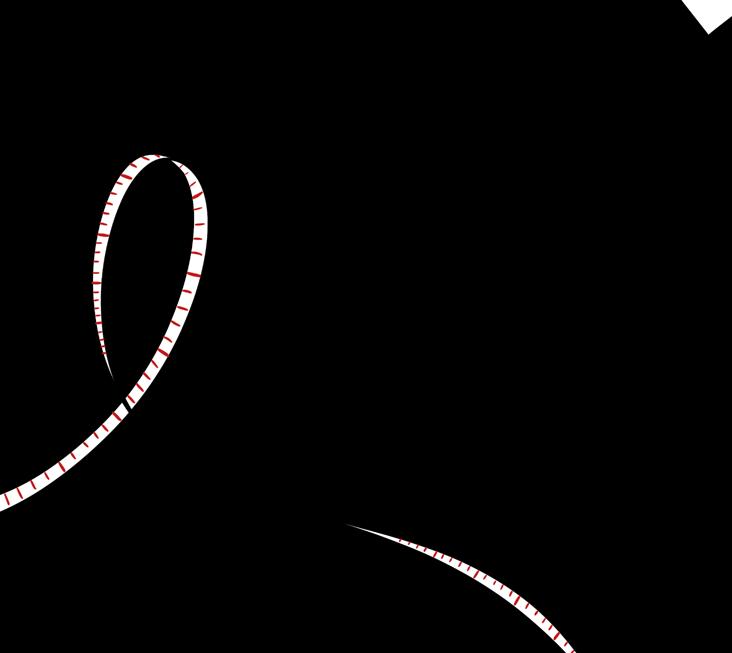


How quarantined students are being treated as the university transitions to fully in-person classes.
BY ADDISON HINKLE • DESIGN BY LILY VINCOLA • ILLUSTRATION BY JULIA DUNNE
With the return of in-person classes, students have been in and out of the classroom quarantining after exposure to the coronavirus. It is tough to imagine the instruction they’re missing and the assignments that these students are accountable for while they’re away. Students are put in a difficult position, through no fault of their own, of keeping up with their academic responsibilities while professors continue through the curriculum regardless of who shows up for class.
According to the office of the Provost, COVID-related absences are treated as excused absences, but that is the only guideline professors are required to follow for students who are quarantining. Vice Provost Sandra Kelly said, “Make-up work for excused absences can take many forms and is at the
discretion of the faculty member.”
For some students, this presents no problems. Emily Brock tested positive for COVID during her second year studying nursing. Her only symptoms were not being able to taste or smell, but she was still capable of completing her schoolwork.
“I didn’t tell [my professors] because I was online anyway,” Brock said.
Blake Walker is a third-year philosophy major and tested positive in late September of this year. Walker fell behind in his classwork, but felt it was through no fault of his professors.
“The way my classes are with philosophy it wasn’t a big deal that I missed it,” Walker said. “[The professors] were very nice and understanding. They just said ‘Let me know if you
need anything.’ But I just skipped those two weeks of class.”
Joanna Logue, a third-year biological sciences major, had a different experience. Logue went into immediate isolation when she tested positive in March of 2021.
“I thought I had a really bad cold … I was really nauseated and my stomach was all messed up,” Logue vsaid. “I couldn’t even attend online classes because I would get nauseous staring at my screen for more than 20 minutes.”
Logue was proactive about the situation. She emailed all of her professors and told the University her test results. The University then sent another email to all of her professors to notify them of her diagnosis. Some of Logue’s professors delayed her due dates. Two of her professors never responded to her email.
“It really just depended on the professor and the type of class. For my STEM classes, those were the ones where I fell behind and had to work harder to catch up. It also happened to be my STEM classes that the professors were not good at helping me catch up,” Logue said.
One of Logue’s statistic professors was particularly unsympathetic. When Logue felt too ill to complete her assignments, she emailed her teacher days before the due date to say that she needed an extension. When the professor didn’t respond, Logue reached out to the University. The University sent a follow-up email to the professor and pointed Logue to the Student Success Center.
Logue eventually mustered the strength to complete her statistic’s assignments since the professor still hadn’t gotten back to her. The professor finally emailed her on the night
the assignment in question was due saying he would look into extending the deadline.
“My statistics class was asynchronous and was very large. The professor had just been really bad with communication throughout the semester, so it wasn’t surprising … I went through multiple avenues to try to get this professor to respond to me,” Logue said. “He replied on the day the assignments were due so I had already done them because he replied at like eight o’clock at night.”
Professors deal with hundreds of students each semester while students are expected to keep up with their work for five classes. If you keep your ears up, you can hear both professors and students complaining about their large workload. With this being that case, let’s treat each other with a little extra empathy during these “unprecedented times.”

G&B Fall 2021 Natal Chart
BY TAYLOR RICHARDSON • DESIGN BY MEGAN WOOTERS
In astrology, the natal chart shows the position of the sun, moon, and other planets at the time of an event. The placements we’ll be looking at for this issue are the sun, moon, rising, mercury venus, and mars signs!
Oddly enough, we made this natal chart almost last in our process for creating the magazine, but it turned out to fit our vision perfectly.
This issue was brought to life on Nov. 5, 2021 at 12pm, making its chart look something like this:
Sun: Scorpio
Moon: Scorpio
Rising: Capricorn
Mercury: Libra
Venus: Capricorn
Mars: Scorpio
So what does this mean?
For starters, this issue has lots of willpower. Scorpio placements are known for their staying power and ease with confrontation, while Capricorn placements are known for being super hard working. In the rising placement, Capricorn is patient, calm, and of course, ambitious. Those signs together in the big three make for a super dedicated person, or in this case, magazine issue.
Secondly, she’s emotional!! Scorpio moons not only have intense emotions themselves, but also seek it out in other people. Like with all Scorpio placements, there’s a need for transformation that feels almost like a core part of their existence. Pairing the intensity of the Scorpio placements with the ambitious placement of Capricorn makes for one super intense issue. When Mercury is in Libra, it leads to charming and diplomatic communication. So basically, you’re going to fall in love with us. We’re so excited it’s finally born and in your hands!
Rumor Has It: YikYak is the New Gossip Girl!
Many of us growing up online have heard the famous line, “Gossip Girl here, your one and only source into the scandalous lives of Manhattan’s elite.” Some of us have even wished to experience the drama and chaos that is Gossip Girl. But what would you do if suddenly Gossip Girl was no longer exposing the just wealthy elite of New York, but rather the students, faculty and staff of UofSC? Would you add fuel to the fire and send in gossip to be viewed by peers? Or would you rather be the Gossip Girl, front and center with the rumors, scandals and inside scoop of your community? Any fantasy can be accomplished with the resurgence of the app YikYak: an anonymous posting app that connects you with your local community.
One of the most enticing aspects of the app is the anonymity the user has while posting and commenting. With this protection from backlash, users are able to post anything from genuine questions to juicy gossip. With easily passable community guidelines, or “guardrails,” posting whatever you want on Yik Yak is easy, just censor a few characters.
With this mentality, some students follow one natural course: exposés. On YikYak, you have 200 characters to write the most scathing text imaginable, damaging someone’s reputation or even humbling someone who dares to overstep. Spreading gossip is made simple, by reposting Yaks to your story, commenting, upvoting and showing Yaks to your friends.
Another feature of the app is herds. Your herd is formed by combining the users within a five-mile radius and sharing content relevant to your area. This helps curate unique content specific to your location and environment, making it easier to understand current news in your community.
BY HENRY TRAVIS • DESIGN BY MARIA DESIMONE
BY HENRY TRAVIS • DESIGN BY MARIA DESIMONE
BY HENRY TRAVIS • DESIGN BY MARIA DESIMONE
BY HENRY TRAVIS • DESIGN BY MARIA DESIMONE
Some of these exposés include mentioning particularly disruptive characters in your class, keeping track of low-rated professors, rude or unapproachable staff members or exposing anyone and anything in between. While it is also known that some stories featured are false, these kinds of allegations can still impact any career or reputation. While newer posts to date are humorous and consist of people making jabs at their friends, there’s still time and opportunity for vindictive damage to take place. Regardless of whether these posts are true or not, with enough traction, they can be featured on a variety of pages including the Local Top Yaks, Local Hot Yaks, Nationwide Top Yaks and Nationwide Hot Yaks. Any feature of negative posts to these pages can sink a once shiny reputation and make life miserable for the intended party.
In relation to the University of South Carolina, Greek life, public figures, parking and commentary about the weather have made up the majority of posts in the past few weeks. However, there has been a rising trend of people posting questions along the lines of “Who’s your least favorite person on campus?” Comments have been flooded with not only first and last names of students, but also stories as to why these people were chosen. While the content of the posts started out focusing primarily on these topics, as the year has progressed, the focus has shifted to new topics. Most recently, the topics discussed have transitioned away from the heat and public figures, and instead turned to commentary about football, parents weekend and college burnout. These topics were seen with posts like “We can still drink to the fact Clemson lost”, “My parents finally witnessed hung over me I feel like this should count as a developmental milestone,” and “the only thing motivating me to get my work done is going to cotton gin tmrw....”.
8
the resurgence of YikYak paving the way for a real life Gossip Girl? 8
Is
Is the resurgence of YikYak paving the way for a real life Gossip Girl? 8
Is the resurgence of YikYak paving the way for a real life Gossip Girl? 8
Is the resurgence of YikYak paving the way for a real life Gossip Girl? 40 4h • <1mi 8 comments 83 28m • <1mi 10 comments 79 2d • ~3mi 12 comments 84 3d • <1mi 9 comments 50 1d • <1mi 1 comment
This growing trend of name-calling and the posting of unrestricted intrusive personal thoughts could be the start of YikYak’s Gossip Girl era.
As of now, media is not allowed to be posted, but it seems like a likely step in order to keep the app alive. If this new feature is added, any accusations will go from hearsay to innocents proven guilty with photographic evidence. This can lead to a rise of student conduct cases, honor board hearings within organizations and even potential expulsion. This addition can also be used to tag campus celebrities locations in order to keep tabs on where certain people are, whether it’s the President of the University, the Head Coach of the football team, or student athletes.
As a disclaimer and a final note, despite what has been said thus far in the article, YikYak is not the villain. They are simply the host for this new age to exist. The drama and chaos seen within the app is created by the users of their own volition, and their desire to spread rumors and start drama. If a Yak is downvoted by the herd enough times, whether it is offensive or just generally disliked, the app will take down the post. Just because there is negativity on YikYak doesn’t mean there isn’t also lighthearted or casual commentary. With that said, go forth, and do good, or go forth and do some damage. The choice is yours.
204 1h • Nearby 18 comments 352 1d • Nearby 50 comments 17 2m • <1mi 2 comments 62 1h • ~2mi 2 comments 204 2h • <1mi 15 comments 12 32m • <1mi 1 comment
Grasses, Flowers, and Plants, Oh My!




A deep dive into the local herbarium and their curator, Dr. Herrick
Brown.
One of the more fascinating aspects of the herbarium, in my opinion, is the conservation aspect, and that was the next question for Dr. Brown. When each specimen is extracted, its exact location is marked, and several species are all taken from the same area at a time. This allows them to recreate an image of what the habitat looked like, as well as produce distribution maps to determine how dense populations are, painting a picture of the habitat when the plants were gathered. This is absolutely crucial to monitor in terms of climate change and conservation, since comparing specimens collected from the same place in different times tells us how these environments are changing. Understanding these changes can help to shape measures to protect or restore these environments. For endangered or at-risk species, they also perform judicious sampling, a technique that gathers the flowering part of the plant without damaging the root system or killing the plant. All of this makes the herbarium an excellent way of conserving plant specimens, their knowledge and

If any of this information sounds interesting to you, Dr. Brown actually runs classes where you can participate in some of these activities and learn more about the process. Dr. Brown instructs a class on fall and spring flora in the fall and spring semesters respectively. While in the class, students will take tours to identify flora around campus, with the final goal being to memorize and identify 150 different plant species. The class also hosts a tour to the herbarium. So if you want to be a botanist or are interested in learning more about our local flora, try enrolling in a class with Dr.
The UofSC herbarium is a little known but very beloved place. Their work in the identification and preservation of plants is something to admire. Their appreciation of nature and all its wonderful eccentricities is incredibly inspiring. So if you’re at all interested in biology, or just want to see some cool plants, enroll in one of Dr. Brown’s classes or take a short trip




to the eclectic little oyster bar where you can enjoy amazing seafood, a casual, fun atmosphere and have an extraordinary experience. daily chef inspired specials
Hour Monday - Friday 4pm - 6pm OPEN FRIDAY & SATURDAY 7PM - 2AM LIVE MUSIC 10PM - 1:30AM THE VISTA 936 Gervais Street | Columbia, SC 29201 | 803-661-7741
FOR THE LOVE OF SEAFOOD Come
Happy
NOT AFRAID TO GO TH ERE: NOT AFRAID TO GO THERE: Drag Queen Fashion
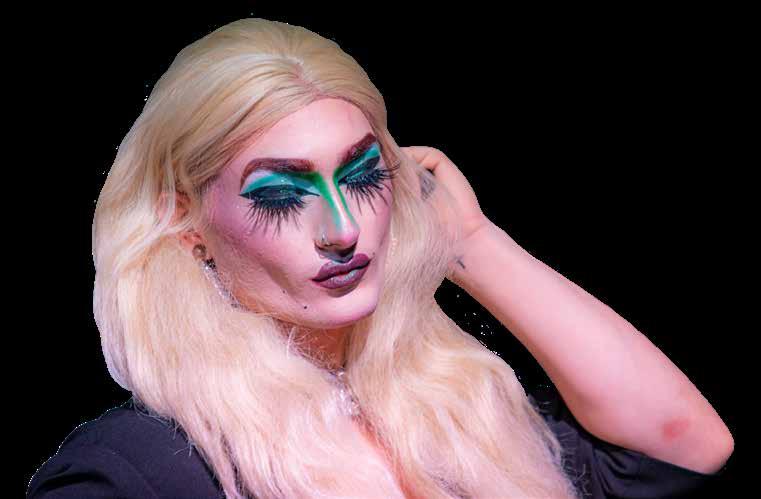
Drag Queen Fashion
BY
 LAUREN JAMES • PHOTOS BY LEXI CROFT • DESIGN BY MELISSA BORGERDING • STYLE COORDINATION BY CAT HARRIS • SNAPCHAT FILTER MADE BY JULIA DUNNE
LAUREN JAMES • PHOTOS BY LEXI CROFT • DESIGN BY MELISSA BORGERDING • STYLE COORDINATION BY CAT HARRIS • SNAPCHAT FILTER MADE BY JULIA DUNNE
Drag shows have existed in many forms for hundreds of years, but the popularity of shows like RuPaul’s Drag Race has helped catapult the art of drag further into the public eye.
The local drag scene is alive and well; finding a venue to watch a show has never been easier.
Tucked in the crowded streets of the Vista lies Capital Club, Columbia’s oldest private gay bar and the gateway to a world of glitter, feathers and sequins that will enchant even the dullest of audiences.

The stage is low and the seating is intimate, but the place is buzzing with energy as rainbow strobe lights illuminate the performers.
But what does it mean, exactly, to be dressed in drag?
I sat down with drag queen, Elena Devour, before her show to get her perspectives on what makes drag fashion different, as well as her favorite parts about expressing herself through drag.
Devour, in her vibrant pink makeup and leopard catsuit, shared her inspiration in the dressing room.
“Drag queens are influenced by the VMAs. For example Doja Cat’s fringe outfit, and vice versa. Drag queens influence pop culture, I think because we are so confident. We’re not afraid to go there.”




And where is “there?” It’s a six-foot-wide pair of wings adorned in crystals, feathers and zebra print, which Devour describes as her favorite piece to wear.
“It makes you feel like a million bucks,” Devour said.
But not all drag queens choose to go that route. Just like street fashion, there are many unique styles of drag that are all eye-catching and glamorous.
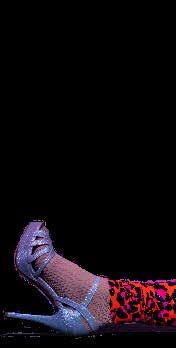
“Drag queens influence pop culture, I think because we are so confident. We’re not afraid to go there”
Houston Hangover, another queen performing at the show, sported a black coat, gold chains and a statement belt. Paired with her stunning blue eye makeup, the look was a contrast to Devour’s bright colors.
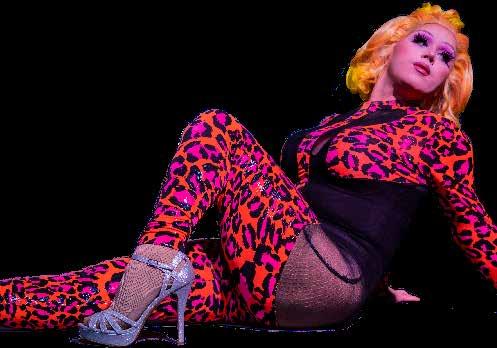
Both queens manage to show their personalities through fashion. In order to get some more insight into what goes into choosing an outfit, I had a conversation with Houston.

How did you get your start in drag?
Houston: I’m from a small town, where there were only like two gay people, and




What is your favorite look you’ve ever put together?




Houston: I did an Alice in Wonderland look one time, that was really cool. I had a tiger print full-body leotard, and then a belt and a jacket. I don’t know, it’s hard to put a label on it because I feel like I try to look the same every time, if that makes sense. Very ‘she was the pretty girl in high school, then she turned alternative, now she just doesn’t care.’



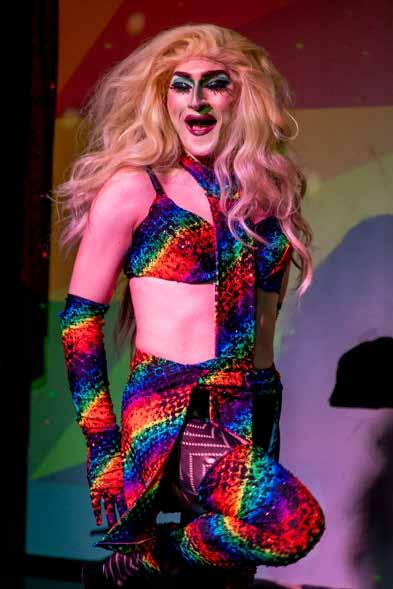

What’s Your Drag Persona? What’s Your Drag Persona?
1. What’s your go-to accessory?
a. glitter, and lots of it!
b. CONFIDENCE
c. flashy jewelry
2. Who’s your favorite pop diva?
a Beyoncé
b. Britney Spears
c. Lady Gaga
3. I usually gravitate towards…
a warm tones
b. as many colors as possible!
c. cool tones
4. I will be performing…

a. “I Will Survive” by Gloria Gaynor
b. “When I Grow Up” by The Pussycat Dolls
c. “Nails, Hair, Hips, Heels” by Todrick Hall
5. What’s your favorite aspect of drag?
a the hair
b. the costumes
c. the makeup
6. What’s your signature move?
a the death drop
b. working the runway!
c. high kicks
If you answered mostly A’s, click on lens one!
If you answered mostly B’s, click on lens two!
If you answered mostly C’s, click on lens three!
Scan the QR code with your phone to reveal your ultimate drag makeover!
EMBRACE FEELING UNCOMFORTABLE
A
LISTEN, Garnet & Black has always been about pushing boundaries, but this semester we’re testing the limits of both our team and our readers. It hasn’t necessarily been an easy experience, but it absolutely has been worth it.
This semester, we set out to tell the stories that haven’t been told – to get into the nitty-gritty details of some, what could be considered, taboo topics. It’s been tough, and we know that some of the stories that lie within the next few pages might not be easy to read either. But why choose to be uncomfortable? Isn’t it so much easier to look away, to leave a room, to stop reading a story? The answer is yes, though it’s hardly ever better. To put it simply, the weight of human existence is heavy for all of us. It can feel like too much to carry on our own. It may be easier for us to not shoulder the weight of experiences that aren’t ours, but think about how much lighter that load could feel if we all just sat in the feeling of being uncomfortable for just a few minutes. We hope that as you read through this section of the magazine that you allow yourself to feel all of your feelings, whatever they may be...
L
LETTER FROM THE EDITORS • DESIGN BY SAVANNAH NAGY
“
“ ”
...We’re all human, let’s share the weight of that together.
The Rules of a Black Woman
How being a Black woman comes with its own set of regulations for existing.
BY ADAIJA DARBY • ILLUSTRATION BY JULIA DUNNE• DESIGN BY CECILIA CALLOZZO
I am forever grateful to be a Black woman, but I’d be lying if I said it wasn’t hard.
To be a Black woman and live in the world is a full time job. We have to worry about political, social, and economic issues that have overshadowed the basic rule of life: to live. To be Black in this world, we have to fight to constantly stay afloat in the deep waters of systematic racism and prejudice. To be Black women in this world, we have to do all of the above, plus make sure to abide by the rules penned in fine print. While these rules were put in place with good intentions, society’s interpretations left them scarred. It’s beyond putting on sunscreen before you leave the house or wrapping your hair at night; these societally-tainted rules have minimized, controlled, and put conditions on the growth, confidence and well-being of the Black woman.
I asked Black women on campus and on social media what they feel are rules that we are expected to adhere to. Through the responses, I’ve realized how much of a box society has attempted to place us in and it’s time to address it .
Rule #1: Be strong.
Society’s interpretation of a Black woman’s strength is the ability to carry the weight of the world on her shoulders without buckling at the knees. “People expect us to be Ms. Superwoman…sometimes we need help,” Labria Rhaney, a freshman at the University of South Carolina said. Many Black women will hide the fact that they are at their wits’ end, just so they won’t be deemed weak. Winthrop class of ‘23 student, Alexiona Carwise, said it best: “It’s amazing to be strong, but when is there time for self care and reassurance?”
The roles of the Black woman have been manipulated to satisfy the lifestyle of those around them, not their own. Black women are expected to turn their independence off in order to stay within the lines of femininity, but turn it back on when in male-dominated spaces. Ji’ya Scott ‘24 wrote, “We’re expected to be independent but not too independent, but not overly dependent either.” God forbid Black women step on a man’s toes because then they risk becoming too masculine to be sought after.
This time spent on other people has taken away from the time Black women have to themselves, thus having negative effects on mental health within the Black community. “Prioritizing ourselves gets lost when trying to help others,” Rhaney ‘25 said. According to John Hopkins Medicine, “... compared to their Caucasian counterparts, African-American women are only half as likely to seek help” Mental Health Among African American Women. This is not to mention the fact that society has conned Black women into “toning ourselves down and suppressing the way we express our emotions,” Korbyn O’banion, junior at UofSC said.
Contrary to popular belief, Black women are not superwomen. They can’t be at the front lines of racial discrimination, persevere through exclusive and uncomfortable work environments, then come home to cook and clean, and have the energy to maintain a social life and relationships without the proper mental breaks and emotional support. Black women should be able to display vulnerability without being labeled as weak. They should be able to seek help without being labeled as crazy. At the end of the day, we are still human. It’s imperative to give Black women a break for the sake of their well-being.
Rule #2: Be humble.
“When a woman is assertive, she’s a b****; when a man is assertive, he’s a boss.”
- Nicki Minaj
In the event that the Black woman is exuding the power she has worked hard to achieve, she is told to “humble” herself.
Humility was always depicted as a good thing, but for Black women, it has acted as a silencer, rather than a trait of good character. A Black woman’s success, in all forms, makes society uncomfortable. Throughout 2021 alone, the media has provided plenty of proof of this.
Through the rise of their music and social media presence, both Chloe Bailey and Lizzo have been ridiculed for loving themselves. It became so bad that both women have had to have emotional conversations with the media just to explain why they love themselves. Black women are forced to defend their possession of self-esteem, just for people to try and diminish it.
Sha’Carri Richardson was America’s home girl - until she wasn’t. After a successful meet, Richardson was praised, and the “I’m Her” statement took social media by storm. However, after the Olympic incident, she hasn’t been allowed to be confident without being reminded of her mistake. The media has changed the narrative and has made her out to be a mean girl because the world refuses to let her move on from it. Ali W., UofSC class of ‘22, says, “We’re expected to take criticism and not say anything about it. When we do, we get called angry or have an attitude.”
It’s imperative to note that the Black community has played a huge part in attempting to humble their women. There is so much internalized misogynoir within the Black community, and unfortunately, it is validating society’s toxic approach towards Black women. Put simply, “it be your own people.” Black women should be able to be loud and proud about their success. According to CNBC writer Courtney Connely, “regardless of a Black woman’s desire to advance in her career, insurmountable barriers ahead of her make it harder to reach the top” How corporate America’s diversity initiatives continue to fail Black women. There is so much work that goes into being a successful Black woman in society.
Justice Kelley ‘22 expresses, “[Black women] have to be above average to get by, while your peers are able to be average and get by. You have to be the best of the best to even get a seat at the table.” After climbing their way to the top, it would be scary to think that, after all of that, they can’t simply be proud of themselves.
Applaud the Black woman in your class, on your Twitter timeline, or at work, whether for big accomplishments or small, it’ll make a huge difference.
Rule #3: Be seen, but not heard.
“The number one rule [for Black women] is to be seen and not heard!”
- Caley Bright
‘24
As soon as a Black woman opens her mouth, she is said to be loud, ghetto, too opinionated or always complaining. “When we voice our opinion, we’re seen as loud and aggressive,” Tyra Latimer ‘23 said. Black women are expected to speak up only when society calls for it; however, many were raised to believe that “closed mouths don’t get fed.”
Black men have been known to silence Black women, especially in the case of domestic abuse and sexual assault. Based on Time’s Up Foundation, “3 of 4 sexual harassment cases are never reported. When they are, 75% experience some form of retaliation” Black Survivors and Sexual Trauma
In the media, Megan Thee Stallion was practically bullied for being shot by a Black man. While the full story isn’t clear, it doesn’t take away from the fact that she was the victim of a shooting, yet somehow that’s been ignored. To this day, the Black community wonders how R. Kelly was able to get away with his antics in the ‘90s and early 2000s, but look at how people treated Megan.
Black women are allowed to say what they feel, when they feel like it. Black women are worthy of being heard, validated, and understood, no matter how “loud” we get. If Black women make you feel small, that’s a personal problem.
I have barely scratched the surface of all the rules of Black women. There are so many others that hold them back from their true potential. Next time you see a Black woman, send words of encouragement while she battles the unjust rules of society, I guarantee she needs it.
Defining Courage cour age \ ’k e r-ij \
Brock Sansbury found strength through recovery from drugs and alcohol and is helping others do the same at the Courage Center.
BY SARAH HUDOCK-JEFFREY • PHOTOS BY SYDNEY BONAPARTE • DESIGN BY MEGAN WOOTERS
Walking into Brock Sansbury’s office, one can see a pile of books with, “Daring Greatly”
by Brené
Brown on top. He explained that he uses the book to teach about the power of vulnerability to the members of the Courage Center.
The Courage Center (TCC) is a designated Recovery Community Organization, which is an independent, local, nonprofit organization led by representatives of local communities of recovery. The mission of the Courage Center is to provide a “safe, supportive, recovery focused setting for young people and families on their journey to recovery from substance misuse or abuse disorder.” They serve members of the community ages 14 to 26.
Deputy Director Sansbury explains that recovery has to be approached in a different way with adolescents and young
adults because the brain is developing. The team at TCC implements a program called MAAPS, or Midlands Adolescent Addiction Peer Support. The MAAPS curriculum is evidence-based and equips young people with the tools and skills they need to carve out a positive life and future for themselves. Furthermore, this program is completely free and TCC offers no-cost transportation assistance if needed.
Sansbury is a person in long-term recovery from addictions that began in his youth. He embraces his powerful story of recovery to relate to and inspire the young people engaged in MAAPS at TCC to live beautiful lives free of substance abuse.
Sansbury grew up in the Midlands, raised by his mother and grandfather. His parents divorced when he was young, and his father was an alcoholic – thus not present in his life. He remembers feeling different from his peers at a very early age. “I remember,
early on in life, I thought differently than other people.” He became obsessed with activities like sports and with his identity as a popular kid.
Sansbury smoked his first cigarette around 11 or 12 and started smoking marijuana around 13 or 14. When he smoked his first cigarette, he threw up but remembered thinking he couldn’t wait to do it again. He drank for the first time in sixth grade, got sick and then couldn’t wait to do it again. “Most people with normal thinking capacities don’t think, ‘I can’t wait to get sick again.’ And, of course, I didn’t know what that meant at the time,” Sansbury said.
He partied through middle and high school and surrounded himself with people who were doing the same things. Over time, he began getting kicked off of sports teams and his grades declined. Sansbury said he had no interest in life at all and barely got out of high school. After graduating, he took a gap year and worked and partied with the same people every

night. Over time, “the nights got later, the drugs got harder, the people got sketchier.” He went back to school at Midlands Technical School and UofSC, but flunked out. Sansbury described that he didn’t have drive and didn’t know who he was. “I was trying to be this thing that I wasn’t, while I was slowly morphing into the one person I couldn’t stand and didn’t want to be, which was my father,” Sansbury said.
For the next six years, he felt like his life was crumbling around him. Things started to spiral around age 22, and then at 24, the DUI’s and arrests started to come, and he began facing consequences. “I wouldn’t change any of it because I don’t think without the kind of mindset that I had, the consequences that followed, I wouldn’t be here talking to you today.”
In August of 2012, Sansbury tried his first opioid and became heavily addicted. In January of 2013, he got another DUI, and he describes that year as a blur. He was selling drugs, getting robbed and spending time
I wouldn’t change any of it because I don’t think without the kind of mindset that I had, the consequences that followed, I wouldn’t be here talking to you today.
with harmful people. Sansbury had dated a woman for ten years on and off and they got back together the summer of 2013 and she tried to save him. He tried to staysober, but his addiction slowly crept back into his life. By September of that year, they had parted ways.

He ended up living alone in a house with a maggot infestation and no air conditioning. Sansbury was 35 pounds underweight, couldn’t take care of himself, had no food in the house, no gas in the car and no money in his account. All he had was a freezer full of liquor. Somehow, he managed to always take care of his dog. “I did not eat the dog food, people have asked me that before,” Sansbury said.
Every morning, he’d wake up, get some change from his coin jar, go to the gas station to buy a Coke, then come back and chase it with some liquor until he passed out. He did this every day. One day in mid-October, the woman he had dated previously kicked in his door and said she wasgoing to call the cops or he was going to call his mom, but she wasn’t leaving until he made a choice.
Sansbury decided to call his mom. His mother and grandfather came and stood in his driveway. When Sansbury faced
them, his mom said, “you’re either going to live or you’re going to die, but I’m done watching you die.” That moment changed everything for Sansbury. He decided that, although things were going to be difficult, he was going to do what was necessary to get better. Two weeks later, he was at a treatment center in Florida. He stayed in a sober living house, living with other young people recovering from addiction. After a year, he moved back home and went back to college.
He went back to school two years after recovery, and attended the College of Social Work at UofSC. He was still trying to figure out who he was, where he fit in, and was welcomed with an incredibly inviting environment. He wasn’t sure if he would feel accepted in a college environment because of the culture of partying and drug use, but through the health and human services at UofSC, he found a place for himself in recovery. People knew he was in recovery andembraced him for it. He met with deans and professors: “I never would have thought that that would happen,” Sansbury said.
Sansbury explains that in other parts of the country, collegiate recovery programs, sober housing, sober fraternities and
That moment changed everything for Sansbury.
He decided that, although things were going to be difficult, he was going to do what was necessary to get better.
sororities are very common and thriving. At UofSC, he met with three of his peers, formed Gamecock Recovery with the Substance Abuse Prevention and Education (SAPE) office and started providing a safe, supportive space for students in recovery. They had eight students at most come to the meetings, but he emphasizes that even “if it’s one person who could utilize the services, that person should have a seat at the table.” He believes this group is so important at UofSC because of the culture of binge drinking and the pressure students feel to participate in it. “And my thing is always, you shouldn’t have to sacrifice your
programs to 31 organizations in the country to combat the nation’s overdose epidemic. TCC is the only organization in the southern region to receive the grant.
This grant allows them to continue to have the program office on Park Road and the administrative office on Augusta Road and to hire some new people. Furthermore, TCC can now work with other aspects of the community, like the criminal justice system, the education system, the medical services and first responders, “trying to bring everyone to one table and provide better community support,” Sansbury said.
Sansbury hopes they can continue
Narcan and Fentanyl test strips. Sansbury says the team at TCC hopes to expand this program into Richland and provide these pouches to social workers embedded within the hospital. They also hope to have someone from TCC embedded within the hospital, once things are alleviated with COVID-19.
For those interested in getting involved with TCC as an ally, anyone can become a peer recovery coach through training or volunteer at events. For those looking to become a member, Sansbury says that “everyone is welcome here.”
Throughout the conversation, Sansbury emphasized how grateful he is to be here

I should be dead and something kept me here to carry the message forward. So one person saved is good for me.
THE MAXCY STAIRWELL
When reports of sexual abuse go unnoticed by the university, a group of students make sure that somebody is listening.
BY ALEX RUZ • PHOTOS BY AARON FALLS • DESIGN BY CASEY HALL
In light of the “Fire Voros” movement, news of UofSC history professor and faculty principal of Maxcy College, Dr. David Snyder, sexually harassing a student from 2018 up until 2020 had come forward earlier this year in March. In an article by FITSNews, UofSC alumni Mary Elizabeth Jones had filed a lawsuit against Snyder and described, in detail, what he had done to her. Jones had also explained what UofSC had done with the situation in which she said she felt like, “the problem.” Once this article came out, five students from UofSC, some of whom used to live in Maxcy College and were very close to Snyder, felt unsettled after reading the news about their former faculty principal. The students were rather disappointed to also find out nothing was going to happen to Snyder.
In April, the five USC students broke into Maxcy College and proceeded to paint a mural on one of the stairwells. What was the mural? A tribute to victims of sexual harassment and abuse. On the walls, it said things such as, “BELIEVE SURVIVORS,” “YOU ARE NOT ALONE,” as well as the National Sexual Assault Hotline number and the on-campus hotline number. Now, with the University planning to paint over the mural, these students want to immortalize their work somehow, and have decided to do an anonymous interview with Garnet and Black to talk about the Dr. Snyder allegations and why they responded the way they did.
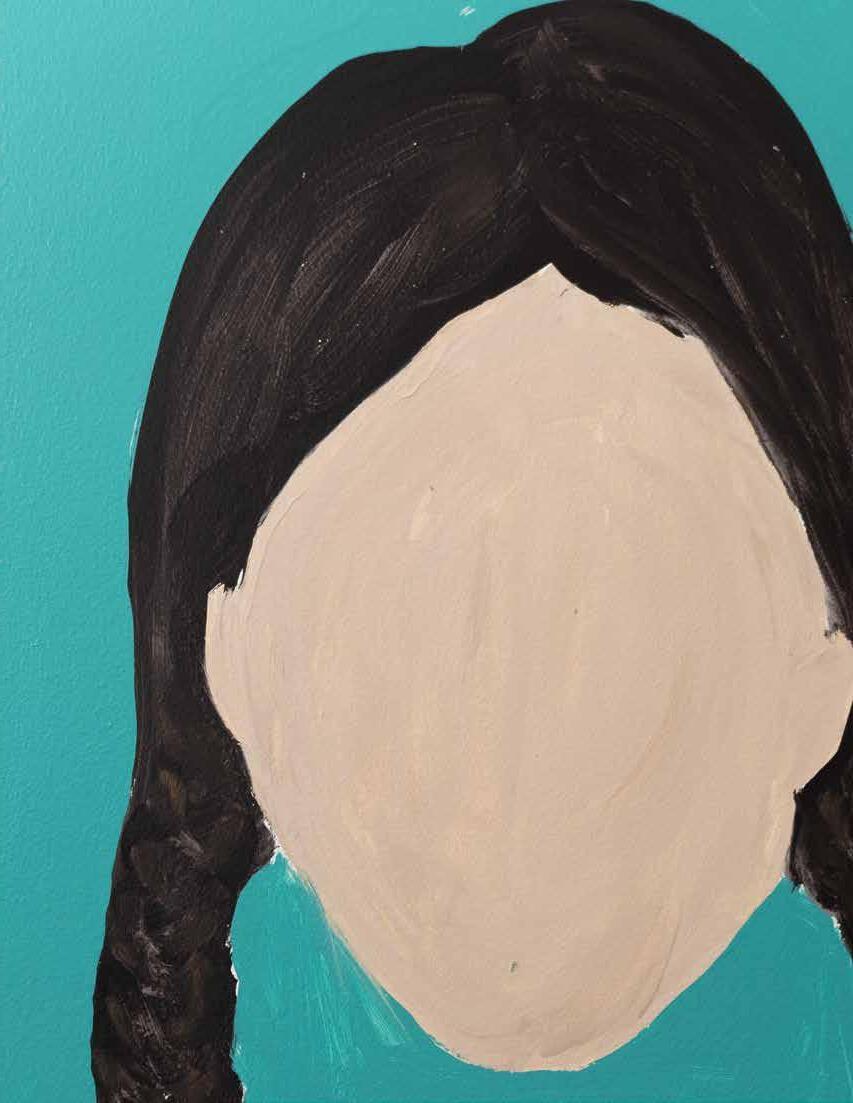
Their initial feelings when they first read the article was shock, they had no idea how to feel or say about it. “We were shocked because it was someone so close to us,” one of the students said. “It was someone we lived with. It was someone who had access to our homes.” Three out of the five students who had painted the mural used to live in Maxcy College their freshman year and they talked about how often they were alone with Snyder and talked to him about personal things. They trusted him and looked up to him, so upon hearing the news they were distraught, but they knew they had to do something.
When asked why they painted the stairwell specifically, one of the students who used to live in Maxcy said that the stairwell was something that meant a lot to all of them. The student heard that Snyder was originally planning to hire an artist to paint the stairwell but due to COVID-19, the plan fell through. The group decided to take that opportunity. “We wanted one part of Maxcy to have nothing to do with him,” one of the students said. “We were angry. We wanted to make something that said, ‘this is a real problem. Look at this.” While painting the mural, they had the intention of keeping it positive, not wanting to slander Snyder nor Maxcy College in any way. They wanted to make it all about the victims, not the abusers. They wanted to reassure victims of sexual abuse that they are not alone.
YOU ARE NOT ALONE
“It’s already hard enough to report something like this,” one of the students said. They explained how difficult it is to reach out to the University and how UofSC has almost done nothing with reports of sexual abuse. Victims of professors on campus are especially vulnerable due to the superiority held over them. “They have control over your grades,” the student explains. “If the university doesn’t believe you, then you have this professor who doesn’t like you anymore.”
Another student, who has no affiliation with Maxcy College, was asked why they decided to participate in painting the mural, especially with the consequences it had and bravely, they talked about their own personal experience with sexual assault. They talked about feeling as though it was their fault—if they had, “said no ten more times then maybe it would’ve done something.” But it wasn’t until years later that they realized it was not their fault at all.
They want to make it known that although the University is known for not doing much when it comes to sexual assault, there are counseling and psychiatric services available to students who have experienced those traumas.

The mural in Maxcy College is not just a response: it’s a message. A message to those who are victims of sexual abuse. It’s a way to say, “We see you. We hear you. You are not alone.” It’s a positive message to reinforce that as UofSC students, everyone has a voice, and they use that voice for those who can’t. The mural is a symbol of activism, of sticking together and advocating for each other. Unfortunately, as mentioned before, the University is planning to paint over the mural. “We think it isn’t right to paint over it. We didn’t do anything disrespectful,” a student said. The students aren’t surprised the University will paint over it, they are actually surprised they haven’t done it yet. The students explained that if the University paints over the mural, then they will be painting over sexual assault resources that students could need. “We painted things that people need to hear. We want people to know someone is listening to them. We are listening to them.”

Editor’s note: Following the digital publication of “The Maxcy Stairwell,” Breanne Grace, Faculty Principal of Carolina International House at Maxcy and Thornwell Colleges, has since reached out to Garnet & Black to assure the permanent preservation of the Maxcy stairwell mural. To find out more about UofSC’s plans for the mural’s future, a follow up interview with Grace can be found at www.gandbmagazine.com.
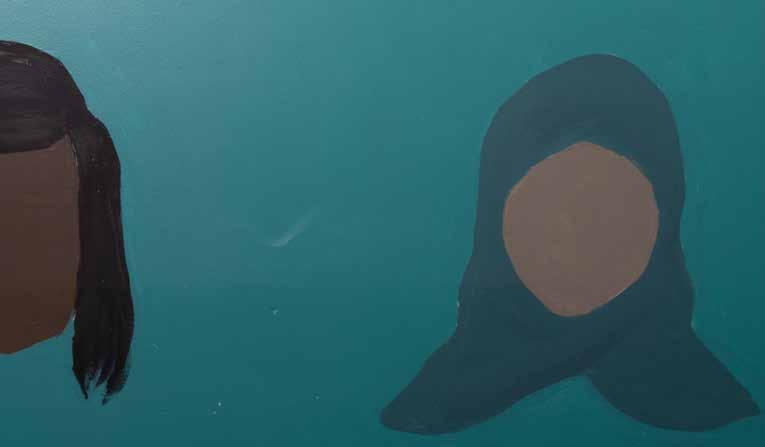

National Sexual Assault Hotline: 1-800-656-4673 Sexual Assault and Violence Intervention and Prevention Hotline (On Campus): 803-777-8248 https://sc.edu/safety/interpersonal-violence/contacts/index.php If you or anyone you know is a victim of sexual abuse, assault, and/or harassment, here are a few resources: WE SUPPORT YOU WE BELIEVE IN YOU
SEX WORKERS IN COLLEGE SEX WORKERS
A student and a sex worker? Yes, you can do both.
BY ALLYSON REAVIS • PHOTOS BY JACKSON TUCKER • DESIGN BY OLIVIA SON
etween tuition, housing, basic needs and fun, college is expensive. Occasionally, a conventional part-time job just won’t cut it when students have bills to pay. Some students turn to sex work to keep themselves afloat and even to build confidence.
Sex work, one of the world’s oldest professions, is a huge umbrella that encompasses many different jobs, not just prostitution. According to Sex Workers Outreach Project USA, sex work also includes things like erotic dancing, webcam work, adult films and being a sugar baby.

Although sex work is illegal in most of the United States, activists push for decriminalization and discussion of voluntary and consensual sex work.
These activists point out that certain demographics, like women, are more likely to get involved in sex work and need the financial benefits it provides.
One anonymous student has a profile on SeekingArrangements, a website with a growing 3 million users that helps sugar babies connect with sugar daddies and vice versa. A sugar daddy is a man who gifts the sugar baby in exchange for services. As a sugar baby, she goes on dates and receives a payment after the date. Occasionally, she will perform a sexual act for a higher sum of money.
Being any kind of sex worker is a choice. She made this choice mainly because it’s “easy money.” She said, “Once you get over the headspace of it all, like you just got to dissociate,
then you can do anything.”
A survey done by Save The Student shows that 10% of students would consider sex work in a financial emergency. The economic impacts of COVID-19 have dug students into an even deeper hole of debt than before the pandemic.
SeekingArrangements states that the average sugar daddy is 38 years old and makes roughly $250,000 yearly. The average sugar baby on SeekingArrangements makes $2,800 monthly from her sugar daddy. This is enough for a student to at least cover rent and groceries for the month.
Mentorship is also a benefit of seeking a sugar daddy. The opportunity for a student to make connections with a successful person in their field is valuable.
The job also comes with responsibilities like maintaining good shape. “You get a reason to work on your body because it’s literally your job,” the student said.
Of course, there are downsides to being a sugar baby. For one, it can be very degrading. “I always feel icky after the fact, because it kind of goes against my moral standards,” she said. She feels remorseful when she uses people for money, but knows that it’s consensual and goes both ways. Not only is she using her sugar daddies for money, they are using her. “So that makes a world of difference,” she said.
Boundaries play a big role in sex work. She points out that her work has taught her how to set boundaries and say no. Sometimes clients will try to bribe the workers, but the student knows that it’s important to know your limits and stick to them.
Even with the rise of platforms like OnlyFans, where over 1 million creators monetize off of exclusive sexual online content, sex work is still
a taboo topic. Students who consider themselves sex workers are faced with the dilemma of whether or not to hide their work from their family and friends. This particular sex-working student finds that being a sugar baby on websites like OnlyFans and SeekingArrangements is difficult to keep hidden because the worker needs to promote themselves in order to gain subscribers or relationships.


The student does not consider her job to be less valuable than a part-time job. However, she does feel like it is more stigmatized. “It requires the same amount of commitment, if not more,” she said. Just like a server, her job is to keep her customers entertained.
Another UofSC student receives part of her income from her OnlyFans platform. Although OnlyFans is not her only or main source of income, it helps her stay financially stable, mainly paying for emergencies.
She holds that having an OnlyFans requires a certain level of self-confidence. “It matters how you present yourself and how you feel about
yourself,” she said.
The OnlyFans worker was struggling with body image issues prior to starting up her OnlyFans, but she faked it until she made it. “I was taking pictures that made me feel good and I would have fun.”
In regards to the stigma around being a sex worker, particularly with OnlyFans, she claims she gets more backlash from guys than girls. When she first started her OnlyFans in February, she had a boyfriend. Anytime she posted, she would have to show him first and get his approval.
Now that she feels more empowered in herself, she doesn’t need permission from anyone to post on her platform. She reaps the benefits and loves it.
“I never, ever, ever will feel degraded by anyone,” she said. “Because I know myself enough to not let anyone take that shine away.”
It’s important to be self-assured if you’re thinking of starting your own OnlyFans. It’s easy to become obsessive over checking your account and seeing how you are growing when you’re self-conscious about what you post. She tries to only check her account about twice a week, just to see if she gained or lost subscribers. “So you’ve got to learn how to put it out of your mind,” she said. It’s normal and okay to lose fans every once in a while and it has nothing to do with the way you look.
Sex work can also be dangerous. The risk of being sex trafficked or being violently attacked is higher for sex workers than the average student. Meeting in public minimizes the risk for a potential sugar daddy or sugar mommy to overstep the worker’s boundaries.
A male student also considers himself to fall under the wide umbrella of sex workers. On the weekends, he dances in minimal clothing at a local queer club for tips. He agrees that it’s

good money, making it a better option than a more traditional job. Also, the hours are flexible and working in a bar can actually be quite fun.
The U.S. is full of thousands of strip clubs. These clubs collectively take in $6 billion every year and dancers make about $17 per hour.
He has a good time working but emphasizes the importance of staying vigilant, as he is responsible for his own tip money. “Drinking on the job is fun,” he said. “It’s definitely a big perk, but you always need to be in control.”
There are times when other dancers’ money will go missing in the dressing room.
Sex work in a public venue can definitely be awkward, since anyone could walk through the door. He recalls a specific horror story, when a fellow dancer’s high school teacher came into the bar while he was dancing. “It’s kind of nice because there’s this mutual understanding that you guys are both doing something you’re not supposed to be doing,” he said.
This student has clear boundaries, like no removing underwear or kissing on the mouth during private dances. Sometimes, clients try to push these boundaries. “Then it’ll be 10 awkward minutes of them trying to make out with me and me pushing them off,” he said.
Although the hours are good and don’t interfere with class times, he wishes that he didn’t have to always work so late. “I don’t get home until like 4 a.m.,” he said.
If sex work is the best option for a student and they know what they are getting themselves into, it can be a good way to keep up with the cost of living and studying. Of course, it’s important to set boundaries and always play it safe. It’s a risky job for those who choose to pursue it, but being a server at a restaurant or store clerk isn’t for everyone. Some of us need more risk, more fun and, of course, more money.
BY ALEX RUZ • PHOTOS BY SYDNEY BONAPARTE • DESIGN BY SAVANNAH NAGY
WHAT DOES GENDER MEAN TO YOU?
WHEN YOU GO ON social meida nowadays, you might see a new addition to users’ profiles. On Instagram, it’s now an option to put pronouns next to your profile name for everyone to see. To a cisgender person (someone who identifies as the sex they were assigned at birth), they may not understand why putting your pronouns in your bio is important. However, to people who are transgender or non-binary, it’s a lot more significant than many others would think. In LGBTQ+ spaces, it’s become just as important to introduce your pronouns as it is your own name. It’s necessary to understand why the normalization of pronouns is happening and why cisgender people have to do it, too.
Upon first meeting, it takes only a glance for people to assume each other’s gender. Assuming can not only be harmful, but also invalidating to people who identify differently from that first assumption. Gender has become a controversial topic among conversations in 2021, and for the most part, is uncomfortable to discuss. The first step to making gender a topic that everyone can talk about is to start with asking each other, “what are your pronouns?” With this question, people can begin to respect each other with the understanding of what their respective gender identities are.
Three LGBTQ+ USC students have continued this conversation for years, and were able to share their insight on their experience with gender and talk about how they express themselves in their everyday lives.

The world is ever evolving and changing, especially with its attitude toward gender.
NAME: Zen, Zenith, or Em
YEAR: Junior
PRONOUNS: They/Them
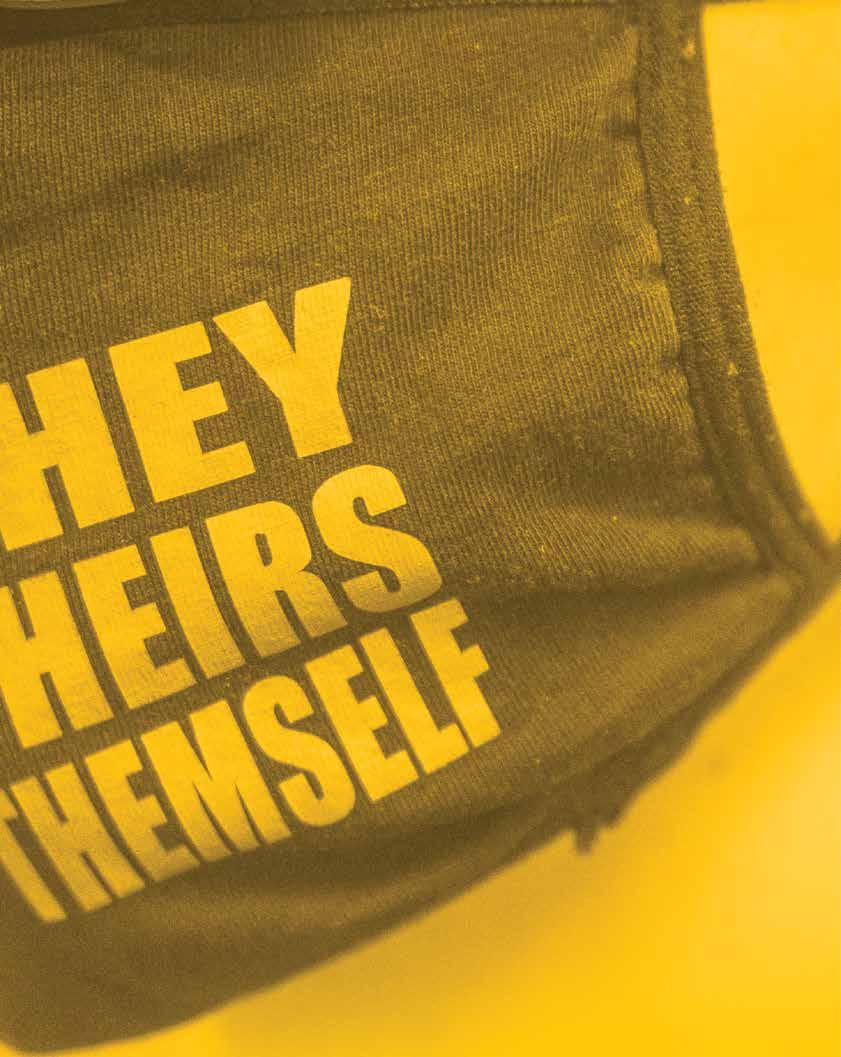
GENDER IDENTITY: Non-Binary
HOW OLD WERE YOU WHEN YOU STARTED QUESTIONING YOUR SEXUALITY OR GENDER IDENTITY? HOW WAS THAT EXPERIENCE FOR YOU?
For my sexual orientation, I wanna say I was 15 or 16 and for my gender identity I was 17. I felt I was probably non-binary but I was too afraid to do anything about it because I didn’t think anybody would recognize me and use my correct pronouns. When I was a four year old child I was saying things like, “Mommy, I’m a tomboy,” and my mom would say, “no, you’re not.” She didn’t even want me to say tomboy; she would always tell me, “you have plenty of feminine interests. You are a lady,” and I would think, “that’s not me.” So, growing up I knew I was a tomboy, and it wasn’t until I met someone who was non-binary that I was like, “wait, that’s a thing?” and made me realize that was me.
DO YOU THINK COMING TO COLLEGE HAS ALLOWED YOU TO EXPRESS YOUR IDENTITY MORE OPENLY? ARE THE PEOPLE AROUND YOU ACCEPTING OF YOUR IDENTITY?
Yes. I come from a very conservative home and my parents are hyper-conservative, so being here, four hours away from my home and able to be myself is so nice. They misgender me and call me the wrong name, it’s a stressful time. I came out to them as a trans-man because I thought they would be able to understand that better, but they didn’t appreciate it. The only reason I came out to them was because they kept asking and asking until one day I told them, because what are they gonna do about it? Nothing. Despite that, though, my friend group is very supportive of me, and sometimes cisgender people will come up to me on campus and compliment my mask with my pronouns on it.
HOW DO YOU EXPRESS YOUR GENDER IDENTITY? FOR EXAMPLE, IS IT THROUGH THE CLOTHES YOU WEAR? THE WAY YOU ACT? THE THINGS YOU DO?
Definitely a lot with my clothing, but it’s always very hard for me to find a nice androgynous balance. I tend to lean masculine to try to pass as just ‘not a woman,’ but it’s very hard to pass as an androgynous, non-binary person, because people always want to put you in one box or the other (male or female) or just take a guess if they can’t tell. I also bind my chest to help with that. The other way I express myself is to let people know my pronouns as often as I can. I put it in parentheses beside my name, when I introduce myself I say my pronouns, my mask has my pronouns — I try to put them out there so I don’t get misgendered.
WHAT WOULD YOU LIKE TO SAY TO THOSE WHO ARE QUESTIONING THEIR SEXUAL OR GENDER IDENTITY? WHAT ADVICE WOULD YOU LIKE TO GIVE THEM?
I wanna say to them it’s okay to explore, it’s totally fine. Feel free to try different things and you don’t have to commit to one thing, you can realize later that one identity doesn’t fit you, but another one does. I started out thinking I was asexual, but then realized that wasn’t correct. Gender is fluid, you can change.
WHAT DOES GENDER MEAN TO YOU?
Gender is a very interesting topic. It’s not just the box society puts people in, it’s more than that. The most simplified role society can place on a person is either nurturing or protective and boxes like that, trying to divide a whole population of people, just doesn’t work. There’s no one person dictating the rules of gender.
NAME: Megan
YEAR: Junior
PRONOUNS: They/Them
GENDER IDENTITY: Non-Binary
HOW OLD WERE YOU WHEN YOU STARTED QUESTIONING YOUR SEXUALITY OR GENDER IDENTITY? HOW WAS THAT EXPERIENCE FOR YOU?
“For sexual orientation, it was probably in eighth or ninth grade, and for my gender identity, I was seventeen or eighteen. I feel like it wasn’t necessarily “scary,” it was just like, “Oh, that makes sense.” It was scary at the start, but then I found a label for it, and it wasn’t scary anymore.”
DO YOU THINK COMING TO COLLEGE HAS ALLOWED YOU TO EXPRESS YOUR IDENTITY MORE OPENLY? ARE THE PEOPLE AROUND YOU ACCEPTING OF YOUR IDENTITY?
“Oh definitely, 100%. My parents don’t really care about what I do, but the high school I came from was really small, southern, and everyone knew each other. It wasn’t a good environment. I feel like everyone around me is pretty accepting of it, especially people I didn’t think would accept it. The worst I got from it, luckily, is just people who say, “I don’t understand what that means!” and having to explain it 800 times.”
WHAT DOES GENDER MEAN TO YOU?
“I feel like it’s just another label. It’s just a check box on a piece paper that I’m check ing off for another person, it’s an expectation from people that you pick either “male or female.” I don’t like the box, it’s too crowded in the box. Gender is too big of a spectrum to be putting people in boxes.”
HOW DO YOU EXPRESS YOUR GENDER IDENTITY? FOR EXAMPLE, IS IT THROUGH THE CLOTHES YOU WEAR? THE WAY YOU ACT? THE THINGS YOU DO?
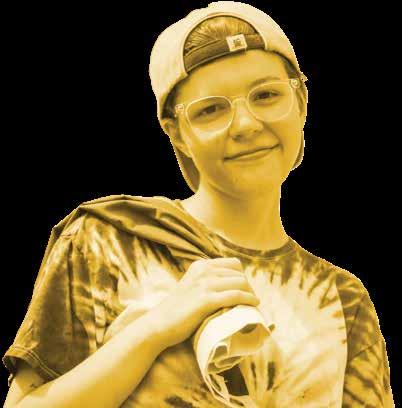
“I feel as though a lot of it is through clothing. It varies by the day, because I feel like there’s times where I dress androgynously, and if you were to pick me out of a crowd someone would say, “oh, there’s the non-binary one!” Then there’s days where I dress more femme and no one would even think I was non-binary. I wouldn’t say I act masculine or feminine, but I act non-binary. Basically: I do whatever the heck I want.”
WHAT WOULD YOU LIKE TO SAY TO THOSE WHO ARE QUESTIONING THEIR SEXUAL OR GENDER IDENTITY? WHAT ADVICE WOULD YOU LIKE TO GIVE THEM?
Express yourself and try whatever you want. If you like it, you like it! If you’re in the guy section of any clothing store and you think, “wow, I really like that shirt!” then get it, go buy it! If you get serotonin from how the shirt looks on you, then maybe look into that, figure it out.
NAME: Dillon
YEAR: Junior
PRONOUNS: He/Him
GENDER IDENTITY: Transgender Male
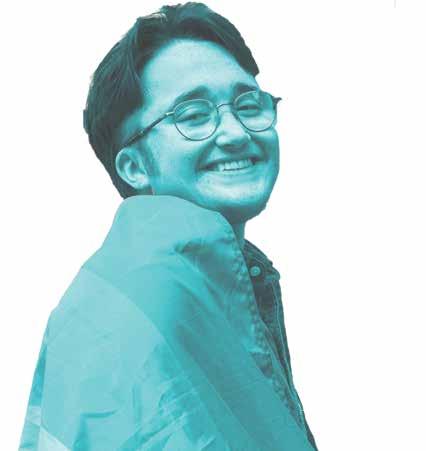
HOW OLD WERE YOU WHEN YOU STARTED QUESTIONING YOUR SEXUALITY OR GENDER IDENTITY? HOW WAS THAT EXPERIENCE FOR YOU?
I started questioning my sexual orientation when I was 13, and I didn’t start questioning my gender identity until I was 18, and I’m 19 now. When I was figuring out my sexual orientation, it had been an ongoing challenge because I had been using the wrong “pieces,” so when I figured out my gender identity that helped me come to a more concrete answer on what my sexuality was.
DO YOU THINK COMING TO COLLEGE HAS ALLOWED YOU TO EXPRESS YOUR IDENTITY MORE OPENLY? ARE THE PEOPLE AROUND YOU ACCEPTING OF YOUR IDENTITY?
Well, in high school I had other friends within the LGBT+ community so I was already comfortable with my identity. People in my life currently are very accepting of my identity. I’m fully out to my parents, my grandparents and even to my superreligious grandma.
HOW DO YOU EXPRESS YOUR GENDER IDENTITY? FOR EXAMPLE, IS IT THROUGH THE CLOTHES YOU WEAR? THE WAY YOU ACT? THE THINGS YOU DO?
I just try to be myself, and the way that’s interpreted, I hope that’s the way I want. The ways I consciously express my gender identity is to look at guys who I find vaguely attractive and see what I find attractive about them so I can obtain it for myself. So that’s why when I first started transitioning I wore a lot of “frat boy” clothes. The days when I feel gender euphoria are the days when I look like a frat guy.
WHAT WOULD YOU LIKE TO SAY TO THOSE WHO ARE QUESTIONING THEIR SEXUAL OR GENDER IDENTITY? WHAT ADVICE WOULD YOU LIKE TO GIVE THEM?
Express yourself and try whatever you want. If you like it, you like it! If you’re in the guy section of any clothing store and you think, “wow, I really like that shirt!” then get it, go buy it! If you get serotonin from how the shirt looks on you, then maybe look into that, figure it out.
WHAT DOES GENDER MEAN TO YOU?
For me, gender is how I perceive myself. And again, how I hope others perceive me. It’s how I hold myself to certain standards to make me feel in alignment with who I feel
EVERYONE’S EXPERIENCE with gender and sexuality is different — there’s no right or wrong way to figure things out. If it’s scary or confusing, just know there is someone who is going through the same struggle. Dressing however you want, expressing either your feminine side, masculine side or even both, is validating in more ways than a lot of people can imagine. When someone who has struggled with their gender identity is addressed with the correct pronouns, the gender euphoria they feel is why it’s important to normalize the question in everyday life. All it takes is for someone to ask, “What are your pronouns?”
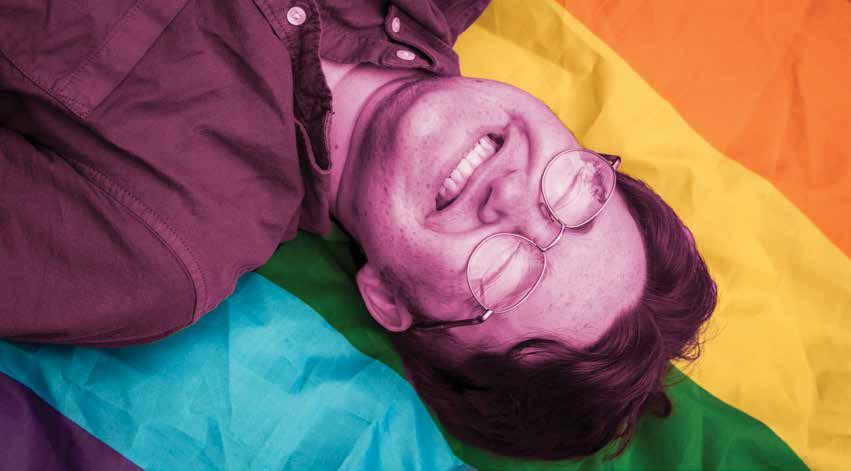
The Invisible
Beauty Standard
The pressure for women to remove their body hair is analyzed and explored.
BY SARAH HUDOCK-JEFFREY • JACOB GARCIA ZAMBRANO • DESIGN BY CASEY HALL
From a young age, women all over the world are expected to shave, pluck and wax their body hair. This ideal is so ingrained into society that many don’t see the unfair double standard and sexist implications. While the movement to reject this standard began with second-wave feminism, women are still burdened today with one question: to shave or not to shave?
Dr. Kathryn Luchok is a faculty member of the Women and Gender Studies Program and affiliated with the Anthropology Department at the University of South Carolina. Her research areas are reproductive health, health and gender and diversity, equity and inclusion. She believes the topic of body hair on women is very under-discussed. “Much of it is taken for granted, and sometimes people do not even realize why they automatically do some practices,” Luchok said.
She explains that body hair removal has not always been the norm for women. The first safety razor was produced in 1901 and was intended for men. During World War I, women couldn’t wear stockings every day due to a shortage of nylon and thus showed their bare legs. Many started shaving and, in 1915, the first women’s razor was released, dubbed the Milady Décolleté and encased in rose velvet packaging.

To continue to sell these razors when the war ended, advertisements heavily encouraged women to shave their legs and underarms “because to not do this was to be unkempt and dirty. To be feminine and pure was to be hairless,” Luchok said. She explains that humans are one of the least dimorphic species, meaning we don’t have as many physical differences between females and males as in other species, so we have created the standard that to be hairy is to be manly to emphasize those differences.
Hair is even associated with enhanced power, as in the story of Sampson and Delilah in the Christian Bible. When Delilah cuts his hair, he loses his power. So, women removing hair also can be seen as removing a challenge to masculine power. The stories of two women at UofSC demonstrate how these harmful stereotypes created in the early 20th century persist today.
Shardae Lamar, a senior political science major, has struggled with feeling unfeminine due to her body hair. She said her experience with her body hair “has been kind of the average girl’s experience, but times two because I have polycystic ovarian syndrome (PCOS).” Lamar found out she had PCOS in middle school. It causes women to have a deeper voice, grow hair in places “that aren’t feminine,” like the back, chest or more on the legs and face, and essentially have more testosterone than the average woman. When Lamar was in middle school, she didn’t feel feminine because of the symptoms. She felt that there was pressure from society that a woman with body hair was not feminine.
Sophomore sociology major Eliza Mitchum said her body hair at times has made her feel dirty and unkempt. Mitchum has felt ashamed of her leg hair. “I realized, after a couple weeks of not shaving, my legs would get hairy, and I felt gross. And I’m like, why do I feel gross and dirty with long leg hair, even though I’m bathing myself,” Mitchum said. She believes this feeling has a lot to do with societal pressure. “The societal norms are that women should be smooth, and that makes them pretty and delicate and soft. And that’s just ridiculous.”
Luchok describes that advertisements from the beauty industry and other media have created a narrow beauty standard. Many women from around the world have darker body hair, yet this image of a white, hairless woman is portrayed. This standard originated in the United States and, for some time, other cultures tended to be more natural when it came to body hair.
The ideal of hairlessness in women has been developed by the patriarchy. In general, women’s bodies are scrutinized, policed and controlled. Luchok explained that women are expected to alter their bodies to stay “forever young to control women’s fertility.” Furthermore, with the relatively recent advent of pornography, this standard has expanded. This form of media shows women as hairless, even with no pubic hair. Because pubic hair comes in around puberty, this standard infantilizes adult women, making them look like little girls, not adult women with power. Mitchum believes the pressure for women to remove their body hair is one of “the most glaring double standards… not shaving is so unprofessional and unclean
for us when men can just exist however they want.”
Despite the rampant misogyny, large majorities of women have bought into these societal norms. The pressure to shave is perpetuated by not only traditional media and advertising, but by social media, families and peers. Mitchum started shaving her legs when she was 13. She was embarrassed of the thickness and length of her body hair and all her friends had started shaving. Other kids would even point out her leg hair and make fun of her for it. So, Mitchum began shaving her armpits and legs and continued for years, and even spent two years shaving her arms as well. Lamar felt very unconfident due to her body hair in middle school as well. She underwent painful and expensive laser treatments to remove the hair, and the maintenance was very tedious.
Both women eventually decided that the pain, discomfort and frustration of shaving was no longer worth being accepted by society. Mitchum noticed that shaving irritated her skin and led to razor bumps, especially her armpits. She decided to make a change, “And I realized, this is not worth it. I am just going to be a human being and have hair,” Mitchum said. And she hasn’t shaved regularly for three years now.
When Lamar got to high school, she began to care less about the hair and noticed that her boyfriend at the time didn’t care either. She started to accept her body hair and stopped doing the laser treatments. “I was like, I’m not gonna put myself through all that again, and I just accepted it, really,” Lamar said.
However, they also both choose to shave sometimes and do what makes them most comfortable and happy. Mitchum never shaves her underarms, and only shaves her legs in the summer. For Lamar, her relationship with her body hair has undergone many changes. When she began at Livingstone College, before she transferred to UofSC, she participated in marching band and they had to wear basketball shorts. “Because I would rarely shave my legs, I didn’t like wearing shorts, but I was like ‘it’s hot,’” Lamar said. So she began to shave. Lamar discovered that she likes the way it looks and the smooth feeling. However, she doesn’t do it all the time, mostly just for special occasions or going to the beach. “Shaving every single day, the standard, would be tedious. So I just shave whenever I feel like it.”
Her current body hair routine includes shaving her legs, underarms and getting her eyebrows waxed. While she doesn’t enjoy the process of shaving or waxing, she likes the feeling afterwards. Lamar emphasized that she now shaves and does other forms of body hair removal for herself, and not anyone else.
In recent years, more girls are growing up seeing women in their own lives and celebrities embracing their body hair. Luchok refers to examples like Julia Roberts, Madonna and Miley Cyrus, who have been photographed with underarm hair. Also, she mentions that some fashion magazines have shown female models with leg hair: “As examples continue in the media, women rethink beauty rituals that
tell us there is something inherently wrong with our bodies the way we are. Accepting each other as we choose to be is a step toward combating shaming and enforcing of body hair norms,” Luchok said.
Mitchum said the body positivity movement has taken off in recent years and given women of different body types, races, genders and sexualities representation, the kind of representation she didn’t have when growing up. However, Mitchum would like to see the movement become more representative of women with body hair.

To any woman feeling insecure about her body hair and shaving without truly wanting to, Luchok recommends looking at photos of women rejecting the status quo, experimenting with longer periods between shaves to see what actually happens and talking with her friends. “She may find out she is not the only one who hates to shave.” Luchok said, “people should be able to handle their body hair however they see fit, and it should not be a way to judge or stereotype individuals.”
Lamar believes that when it comes to beauty standards like hairlessness, veryone should be true to themselves. “If you feeling beautiful involves you putting yourself through pain that you don’t want just to live up to a beauty standard, then that’s not fair to yourself. So, just be you, be who you are, accept whatever dimple or freckle or hair, whatever you have, because we’re all different. So it doesn’t really matter” Lamar said.
1 Must be 18 years or older to apply. $50 Loyalty Select Bonus requires enrollment in Founders Online and eStatements and ten qualifying transactions within 60 days of account opening. Qualifying transactions include, debit purchases, deposits and ACH transactions. Founders will deposit the Bonus into your Loyalty Select by the next business day after satisfying all requirements. One Bonus per member. If you do not have a Loyalty Select, if eligible, one will be opened for you. The account ownership will mirror your primary savings account. For full terms, conditions, and qualifications regarding Loyalty Select, visit foundersfcu. com/loyalty-products-terms-and-conditions. Members with a negative account balance or loans 60 days or greater past due at a time the bonus criteria are met will be ineligible for the bonus at that time and it cannot be earned at a later date. Account will convert to a regular Founders account four years after account opening and will be subject to the terms and conditions, including foreign ATM fees, outlined in the Membership Agreement and Disclosures for all regular accounts. One four-year term per member. Members with an existing checking account, excluding Fresh Start Checking, may have the account converted to the Collegiate Debit account for qualified members and will maintain the same ownership. Members’ accounts not in good standing, as defined in the Membership Agreement and Disclosures, may convert to a regular checking account or be closed.
2 Surcharge fees may apply when Founders Visa Debit or ATM Card is used outside of the CO-OP ATM network


or at foreign ATMs. 3 Members may be liable for non-Founders FCU foreign ATM fees. 4 Limit of five referrals per member. Referred person cannot have a member relationship with Founders and must meet the $50 Loyalty Select Bonus criteria for Collegiate Debit for referring member to receive the referral bonus. Referral terms and conditions, including termination of the referral program, are subject to change without notice. The value of the referral bonuses may result in miscellaneous income received from FFCU and we may be required to send you, and file with the IRS, a form 1099-MISC (Miscellaneous Income) for the year in which you participate and are awarded the referral bonuses. You are responsible for any tax liability related to participating in the offer/program. Please consult your personal tax advisor if you have any questions about how this could affect your taxes. FEDERALLY INSURED BY NCUA. NOT A MEMBER? VISIT RELAXJOINFOUNDERS.COM OR AN OFFICE NEAR YOU TO SEE IF YOU QUALIFY FOR MEMBERSHIP. COLLEGIATE DEBIT1 up to $175 in bonus cash1,4 NEED CASH? WE HAVE OVER 30,000 SURCHARGE FREE ATMs!2 ZERO BALANCE REQUIREMENTS NO FEES ON FOREIGN ATMs3 FOUNDERS APP ON APPLE & ANDROID RELAXTM ... ADULTING JUST GOT EASIER.
Throughout the shoot, we wanted to highlight Native American traditional wear to honor Native roots while visually representing their culture in modern, professional attire. The idea was to illustrate the transition of Native culture meeting society. The purpose of this shoot was to show that Native Americans can still honor their heritage while working in a commercial society. It provides a visual representation of Native Americans in education and the workforce to show the younger, indigenous generations that they can do it too.
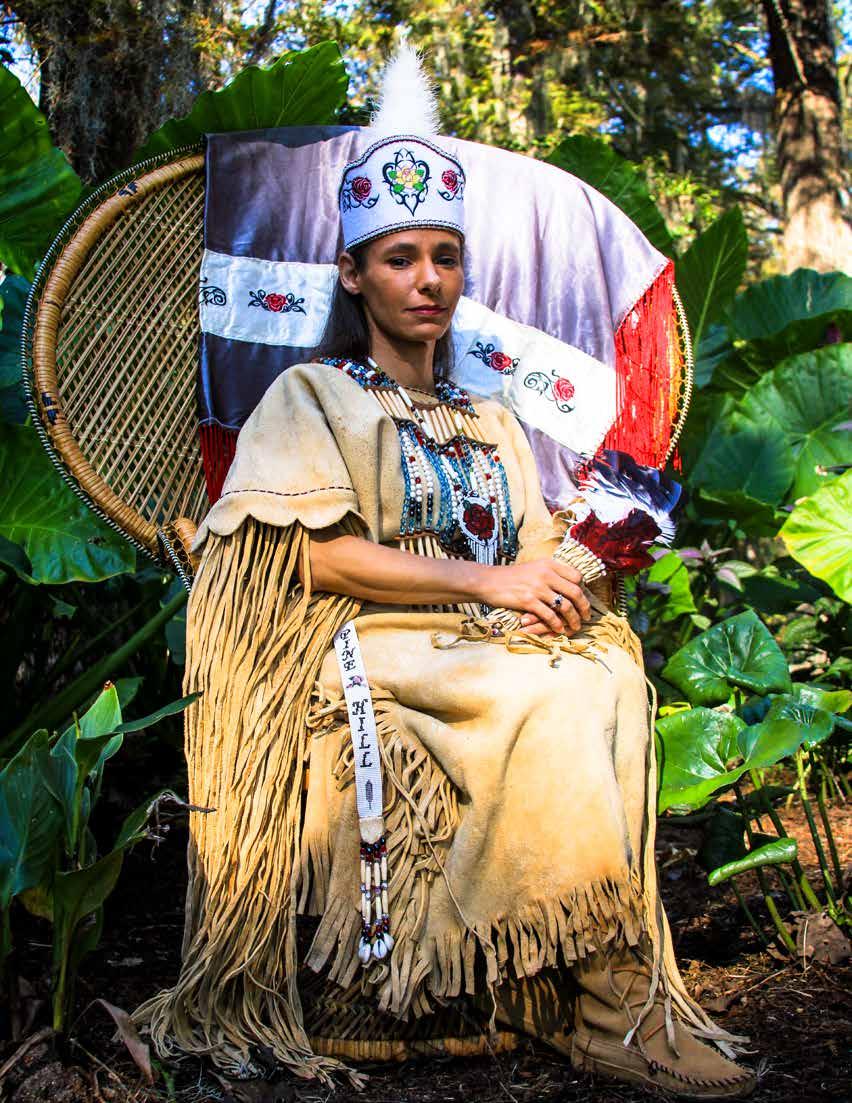
Native Americans are Not Invisible
Native Americans are our neighbors, so why don’t they have access to the same resources as us?
BY ALLYSON REAVIS • STYLED BY CHELSEA WATSON
BERNARD AND JULIA DUNNE
PHOTO BY CHLOE CAUDILL • DESIGN BY JENSEN
ative Americans are not hidden away on reservations in the west. They’re interlaced into our demographics and an integral part of our history and culture as a country. You may be surprised to learn that although the Catawba is the only federally recognized tribe in South Carolina, there are nine state-recognized tribes and at least six state-recognized groups or organizations too.
One of these groups is the Pine Hill Indian tribe of rural Western Orangeburg County. Michelle Mitchum is the Chief of this matriarchic-structured tribe. Chief Mitchum is a 47-year-old retired paralegal who worked for the Native American Bar Association and eventually dove into community health work. Her story is unique, but it highlights some of the common major problems with the treatment and visibility of Native groups in the US. Chief Mitchum’s daughter was born when she was only a senior in high school. From an early age, Mitchum recognized the importance of education for people like her to explore life beyond the tribe. However, her tribe had different plans for her. She was forced to turn down a college scholarship as she had grown into the position of Chief of her Tribe. Chief Mitchum saw this as a “boundary,” not as a “limit.” “Our people do not see limits, but we recognize boundaries. Boundaries move,” Chief Mitchum said. She was not going to let her tribe and societal limitations control her.
By the time she decided that she would pay for college herself, she had her second child. She found herself cemented in the life of a Chief that she wanted no part of at the time.
There’s no way out of becoming a Chief. It is a, “generational, lifetime title,” according to Chief Mitchum. She began her career as a paralegal, receiving her Associate’s Degree and eventually her Bachelor’s Degree in Paralegal Studies at what is now Purdue Global.
Education has never been an easy path for Native Americans. The boarding school program implemented by the government from the 1860s-1960s tore young Native students from their cultures and forced them to assimilate into white culture. The motto of these schools was, “Kill the Indian, save the man.”
The effects of these assimilation programs have affected young Native Americans’ access to education with the official policy ending less than a century ago. Today, 29%-36% of all Native American students drop out of school. This rate is even higher in areas with lower cultural understanding like South Carolina. In 2014, the Obama administration declared Native youths and their education to be in a “state of emergency.”
Mitchum was determined to be different and incite change. Her mother’s generation was the first in her tribe to graduate high school. “My adult life started out with a baby and being told what I could not do. The truth is, don’t tell me what I can’t do because I will go do it anyway,” Chief Mitchum said.
It’s almost a universal experience for Native children to feel stuck. “When you’re born into a generational poverty community, you almost have no chance of getting out,”
Regalia: Traditional Native American Ceremonial Wear
Regalia: Handmade by Michelle Mitchum Shawl: Handmade by Michelle Mitchum Shoes: Moccasins, handmade by Michelle Mitchum Accessories: Beaded Rose Necklace which was handmade by Michelle Mitchum. The fan was a gift, but Mitchum beaded the handle.

“...don’t tell me what I can’t do be ca use I will go do it anyway”
Chief Mitchum said. This systemic-based generational poverty is hard to overcome. Societal oppression makes it even more difficult for kids to get out of their situations. The kids have to be really determined.
When Chief Mitchum went to college, her university was excited to have a Native American student. “Very often I felt like the token Indian,” Chief Mitchum said. She was good for demographics, but the school did not care about introducing actual native issues.
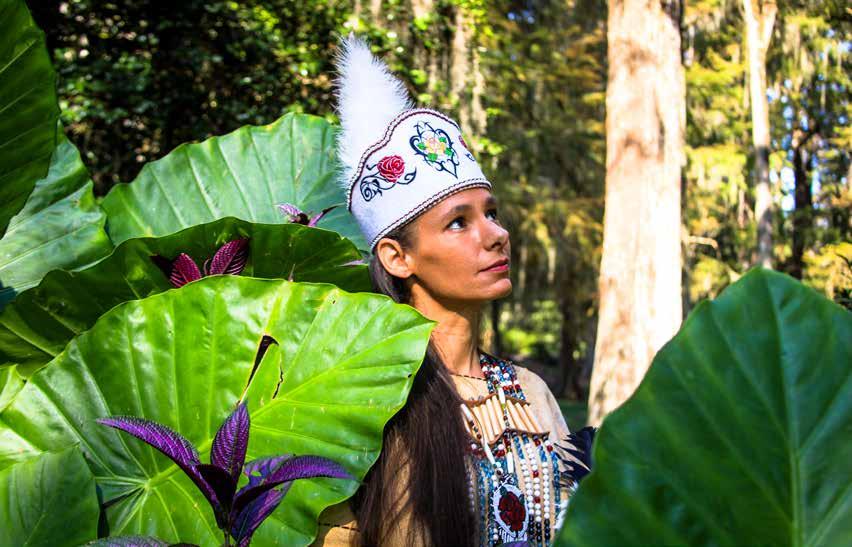
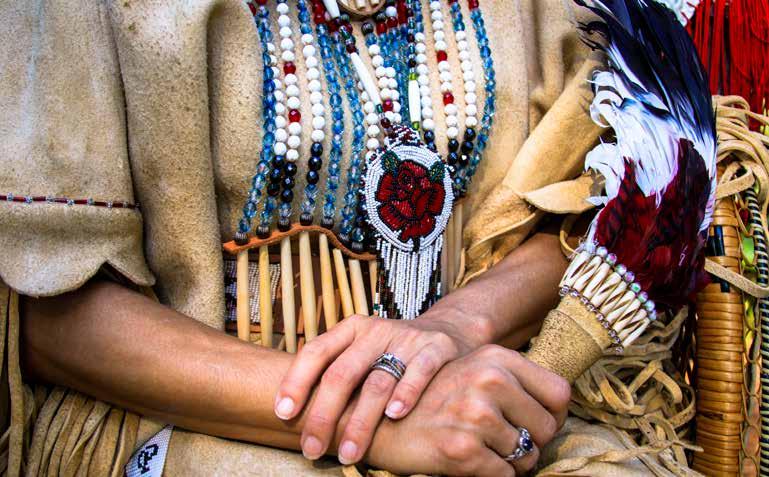
People would call her a witch and claim that she “worships dirt,” when, in reality, she and most of her tribe are members of a Christian church just like so many of us. Her history classes were in direct conflict with the experiences she dealt with in her life.
Even as a mother, Chief Mitchum noticed the mishandling of Native history and culture at the hands of school teachers. Her son’s
first grade teacher did not understand why he was different from the other students, even going as far as treating his race like a mental impairment.
Heritage isn’t celebrated until November rolls around and suddenly it’s Native American Heritage Month. “It’s like Halloween for the other kids and they are the subject of the joke,” Chief Mitchum said. There is no wonder students drop out. They don’t feel understood or heard. They feel hopeless about their future and unable to afford education in the first place.
Common alternatives for Native kids that do not continue with school are either joining the military or becoming a criminal. Chief Mitchum’s own son joined the marine corp, which allowed him to see the world in ways he never would have in Orangeburg.
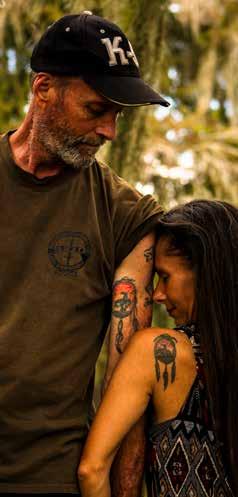

Chief Mitchum points out the issue of recidivism in her community. She defines recidivism as, “Once you go to jail, you’re perpetually going to be in jail.” When she worked as a paralegal, she supported a Native American kid who was arrested for shoplifting because he needed food. Growing up in poverty, his criminal career was already set up for him. Another time, she struggled to help a Native inmate since he had only a third grade education. He couldn’t read or write so the plea agreements were impossible for him to understand.
Overtime, the government has implemented laws to protect Native children and communities. For example, The Indian Child Welfare Act of 1978 was meant to govern the removal of Native American children. However, it only protects federally recognized Native American children. This leaves out children like Chief Mitchum, who ended up in foster care several times as a child.
“Sometimes the laws just weren’t enough,” Chief Mitchum said. Sure, laws can be designed to protect us, but it’s all in the hands of the powerful people who manipulate them. That’s one of her favorite parts of her career as a paralegal. She could protect people from those who try to exploit the law.
Chief Mitchum believes a community should not be limited because its resources are limited. This applies to the healthcare system too. Medical assistance is not readily available for rural native communities.
“Where there wasn’t, we created,” Chief Mitchum said. She retired from her work as a paralegal after 20 years to focus on community health after having her own health emergency. Thus, Pine Hill Health Network was born. The Pine Hill Health Network provides, “health and nutrition classes, diabetes classes, domestic and family violence assistance and awareness, behavioral health advocacy, and preventative substance use/misuse and sexual health education,” according to their website.
Indian Health Service found that Native Americans today have a life expectancy that is almost six years less than the U.S. all-races population. Even immunizations are not readily available to these rural communities. There are many rural communities in S.C. where mothers don’t have nearby access to an OB/GYN. Through Pine Hill Health Network’s health education, Chief Mitchum is able to combat health issues associated with isolation and poverty.
The most fundamental piece in improving the lives of Native Americans, according to Chief Mitchum, is education. First, people need to see and hear Native Americans in their own communities. Chief Mitchum points out that people don’t pay attention to who is around them. “If you see me at Walmart, would you think I was Native or would you think I was Hispanic?” asks Chief Mitchum. Native Americans are all around us and they are not all easily recognizable.
Historical information about Native Americans is not readily available. This is mainly due to the Negro Act of 1740 passed in SC, which made it illegal for enslaved African Americans to move abroad, assemble in groups, raise food, earn money and learn to read and write. The history of Native Americans is intertwined with that of African Americans. Natives were classified as mulatto, or people of mixed African and European ancestry, in S.C. for hundreds of years. They had to be self-identifying and were not allowed in the census.
Native Pride Bottoms: Ribbon Skirt which was handmade by Michelle Mitchum Top: Cream Sleeveless Top, Qearal Shoes: Brown Knee Boots from JCPenny
Native Causal Dress-wear Dress: Tribal Print Dress from Le Fash Shoes: Brown Knee Boots from JCPenny
This makes it even harder for educational institutions to have access to knowledge about Native Americans, especially when they refuse to listen to the Native voices who do speak out against false information. Chief Mitchum is on a committee dedicated to removing the Christopher Columbus Statue in Columbia. “Where he landed his feet was a complete massacre,” Chief Mitchum said. Still, textbooks call Columbus a hero of civilization.
“The history not being told correctly is kind of the core of the problem,” Chief Mitchum said. The federal government can implement laws to increase access to education, but it all comes down to how that one individual teacher decides to present American history.
Teachers choose to focus on viewing Native Americans through a historical lens that makes people “Native American by birth,” but a “mythical unicorn” by the standards of society, Chief Mitchum said. The school systems need to be reformed at the most intricate levels to make sure that Native American students feel heard and that the other students grow up understanding the heart of American culture.
Bottoms: 9 to 5 mini skirt, Corbeau $40
Top: 9 to 5 blazer from Corbeau $48
Accessories: Beaded Rose Necklace which was handmade by Michelle Mitchum
Shoes: Brown Knee Boots from JCPenny
 Academia Wear
Academia Wear
Women in the Workforce
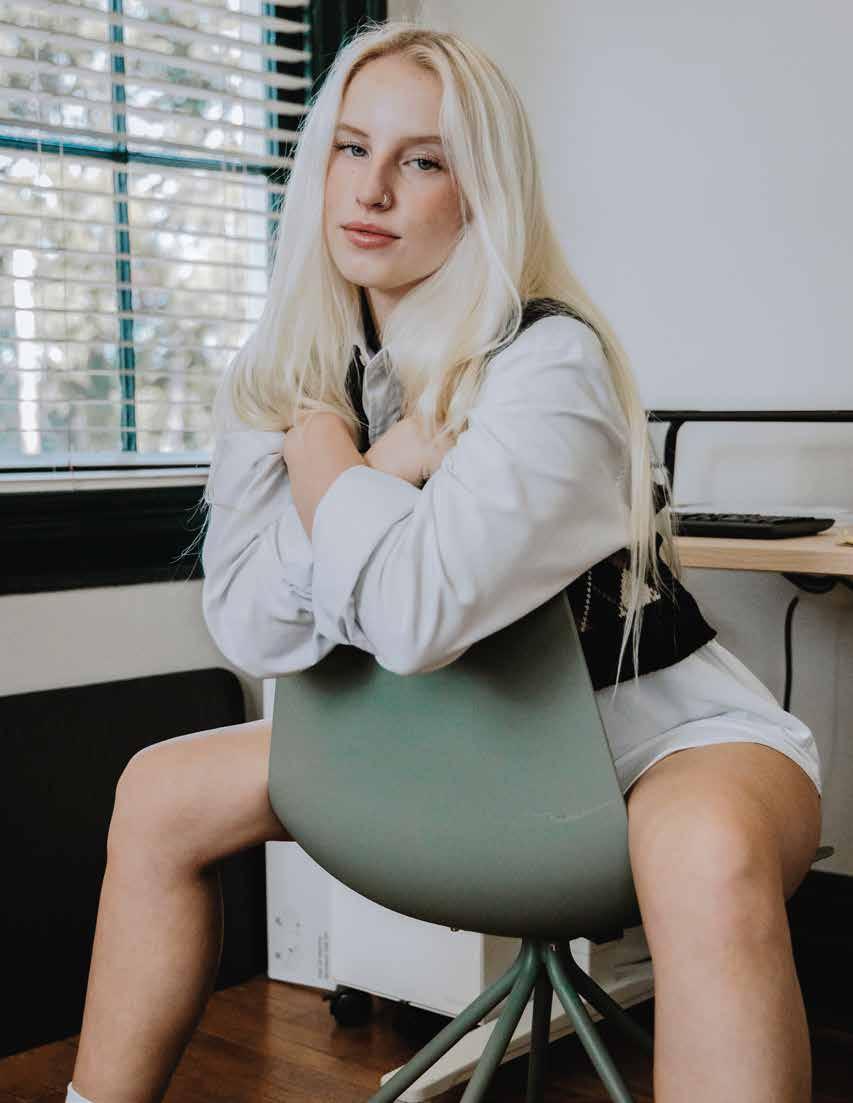 PHOTOS BY ABBY DETORIE AND DEV PATEL • DESIGN BY JULIA DUNNE • MODELED BY BAILEY ZIPP AND JA’LENE JAE’KIAH WOODS • STYLE BY CAROLINE CALLICUTT
PHOTOS BY ABBY DETORIE AND DEV PATEL • DESIGN BY JULIA DUNNE • MODELED BY BAILEY ZIPP AND JA’LENE JAE’KIAH WOODS • STYLE BY CAROLINE CALLICUTT
Close your eyes. Picture an office building. Imagine the stuffy cubicles, the sticky note-covered desks and the sparsely decorated conference rooms. In my mind, I see tall men in drab suits pacing in their small offices, chatting at the coffee-stained Keurig and rapidly emailing a chain of other tall, suit-clad men. As of December 2020, according to the U.S. Bureau of Labor Statistics, women officially outnumber men in workplaces across the country. This statistic changes that mental image for me. For years offices have been dominated by men, the media has portrayed women as sexy receptionists and nothing else, and women have been fighting for equal pay and fair maternity leave. Now there are more women in these spaces than
ever. This shoot is meant to empower all women. As more women are entering these spaces, and finding the stench of the patriarchy is still lingering, clothes can be a statement and a shield. As exemplified in this shoot, women can rock business wear and still be stylish. Playing with silhouettes, like pairing a big blazer with a LBD and cropped vests with big button up shirts are just a few ways to feminize typical “menswear” pieces. Women deserve to be in these spaces. Office buildings still have a long way to go to accommodate their new majority. Speaking for myself, I do my best work when I know my outfit rocks. This shoot aims to show that women do not have to sacrifice style or femininity to look professional in office settings.

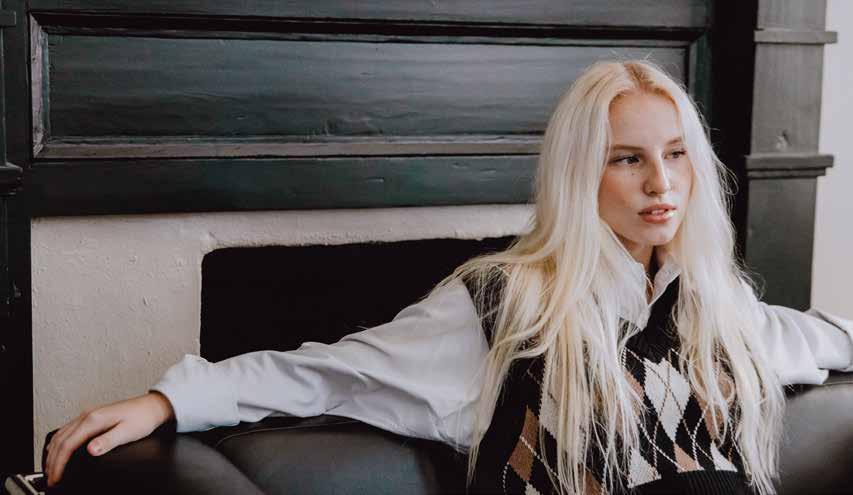
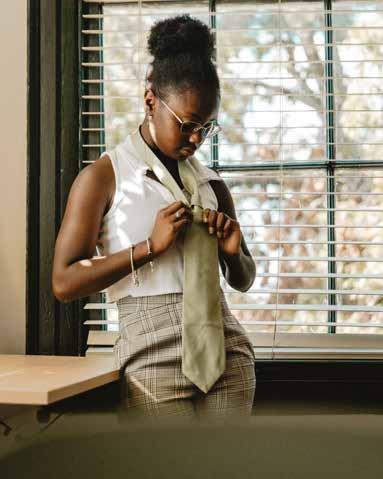
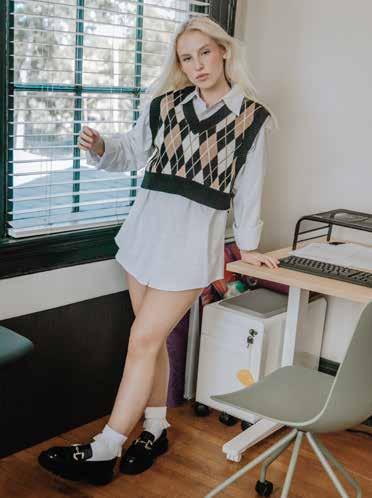
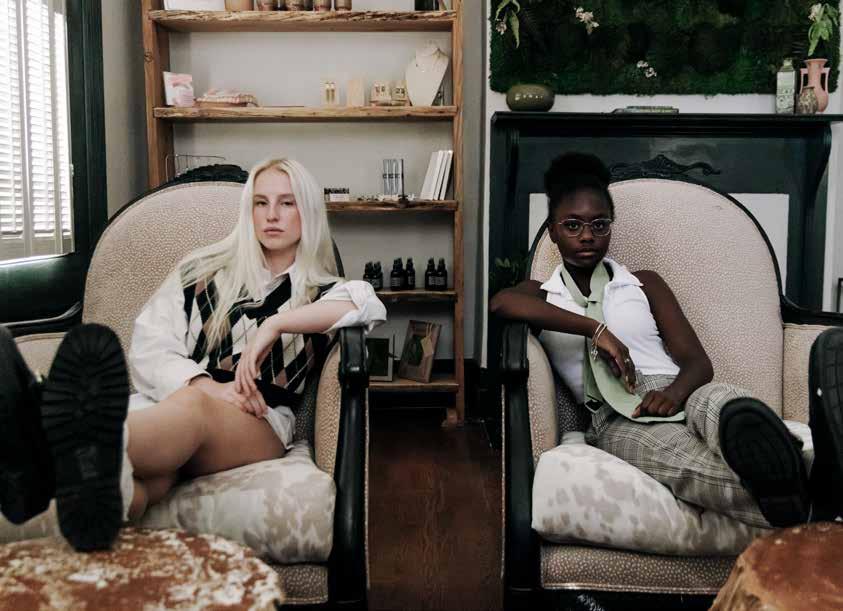

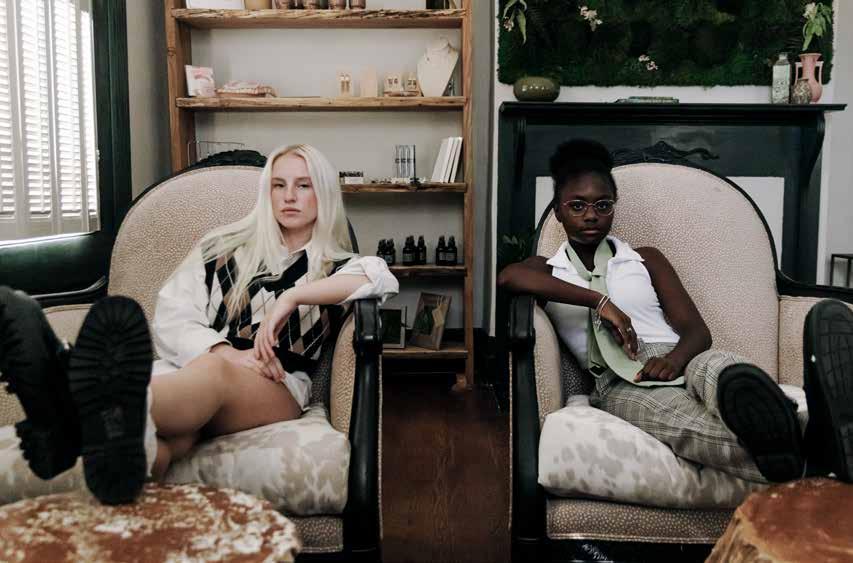


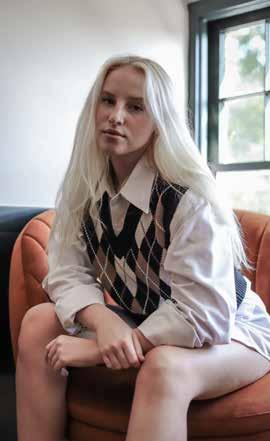 Leather dress: Vestique
Trousers: Vestique
Leather dress: Vestique
Trousers: Vestique
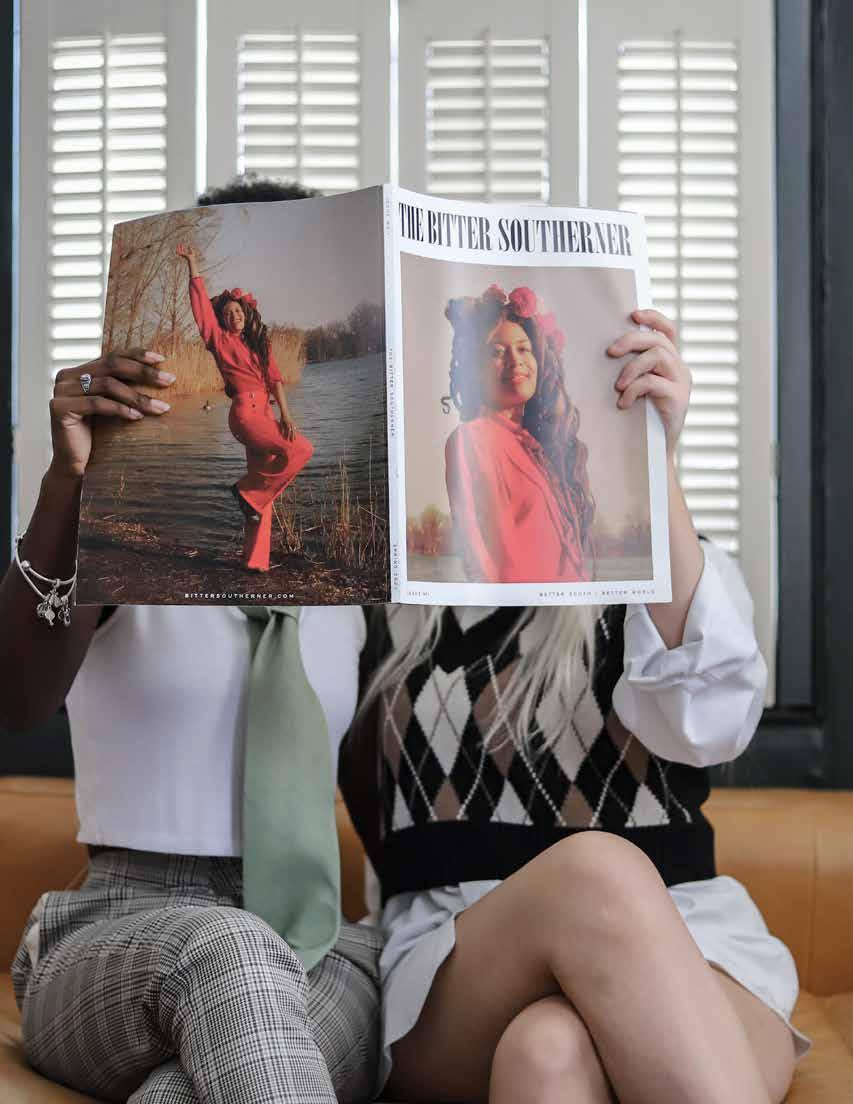

 BY CARSON PEADEN • PHOTOS BY FREDERICK GAUSE AND SHAIRA NIXON • DESIGN BY SHAIRA NIXON • STYLED BY TONI DELOACH • MODELED BY: DEVIN WILLIAMS, AMBER GLOVER AND ZAMANI LYDE
BY CARSON PEADEN • PHOTOS BY FREDERICK GAUSE AND SHAIRA NIXON • DESIGN BY SHAIRA NIXON • STYLED BY TONI DELOACH • MODELED BY: DEVIN WILLIAMS, AMBER GLOVER AND ZAMANI LYDE
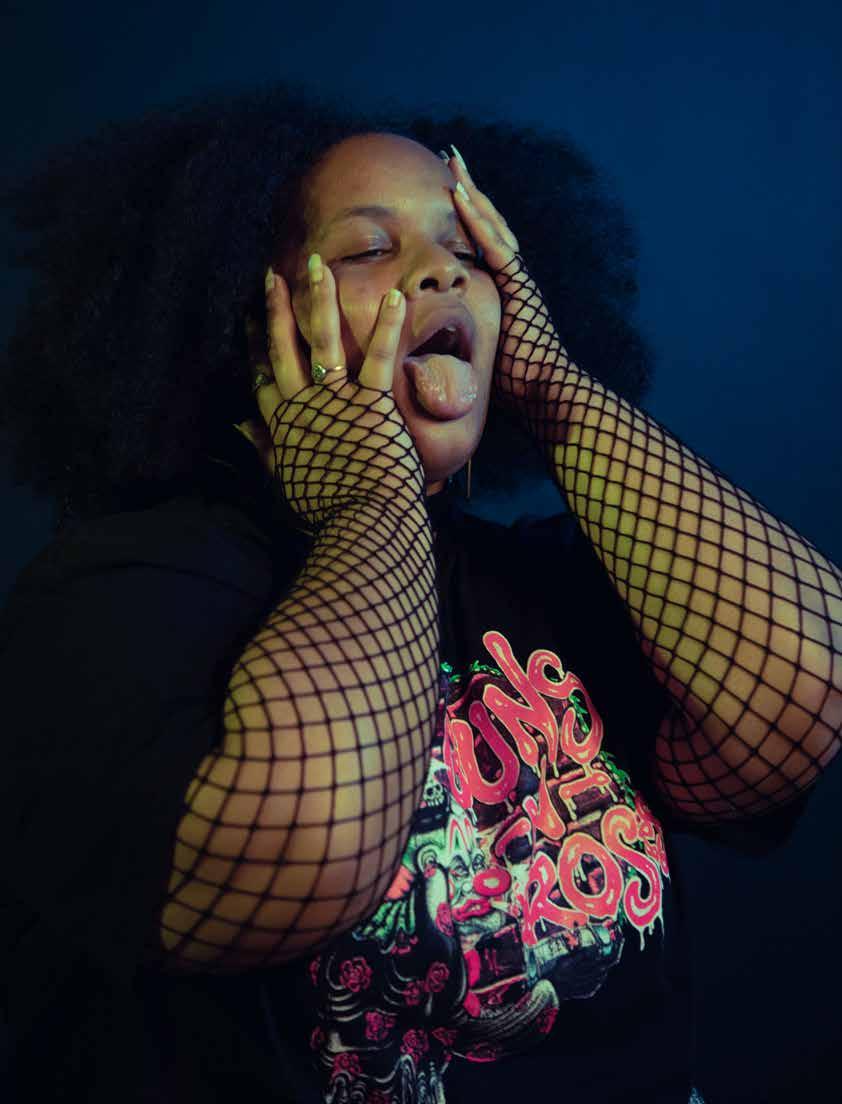
The local punk and alternative scene in Columbia may be small in comparison to other cities but it certainly isn’t quiet.
BLACK BEING BLACK BLACK IS
PUNK PUNK PUNK IN ITSELF
Those that identify with punk and alternative subcultures pride themselves in personal expression and nonconformity. From their clothes to the bands they like, they emphasize the importance of individuality, which means everyone has their own idea of what it is to be punk.
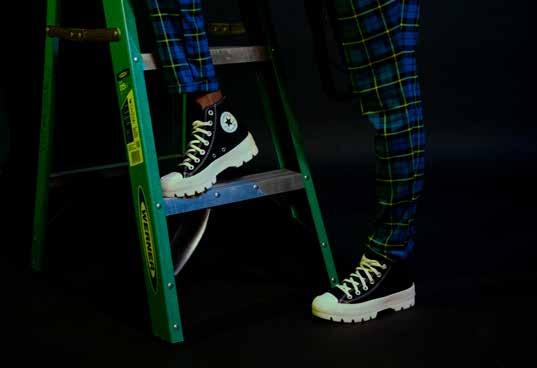
“It’s more of a mindset, not necessarily a lifestyle, because there’s no defining factor,” said Nori Noir, a 34-year-old fashion designer and artist from Columbia. “It’s kind of hard to say punk is one thing because I feel whenever you start to try to categorize punk, it becomes un-punk.”
Noir finds that the versatility and expansiveness of punk is one of their favorite parts about it. “I love that everyone can find their own place where they fit in,” they said.
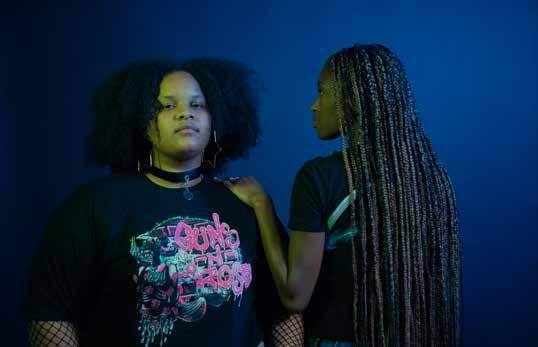

Noir is the creator and designer of Internet Crush, a clothing brand that combines chic, grungy streetwear with high fashion. With the goal of sustainability, the pieces are repurposed vintage clothing, which they spend hours of thrifting a week to find. A quick glance at the brand’s website reveals a range of fashion: studded platform boots, band tees and chained skirts.
Some of Noir’s inspirations include the 80s and 90s style icons, like Jeremy Scott and Vivienne Westwood, and even anime. In other words, “it’s a mix of nostalgia, icons and the current Internet,” they said.
Noir embraced the punk alternative scene around middle school when they felt an urge to deviate from the mainstream. Some of their early fashion choices included drawing and painting on their clothes or splitting them in half and sewing them back together.
For them, fashion is wearable art. Often, it is the first aspect you notice about someone. It’s “the first thing you get to say to anyone without saying anything,” Noir said, pointing to their outfit, piercings and tattoos, most of which they did themselves when they were a teenager.
Noir currently has a studio with their work at Tapps Outpost, a hub that supports upcoming artists in the Columbia area.
While many Black people are a part of the punk and alternative movement, it has been whitewashed since its emergence in the 1970s. Like most musical genres, it fails to credit the influence of Black creators. For instance, rock ‘n’ roll owes its birth to artists such as Chuck Berry, Little Richard and Sister Rosetta Tharpe.
“Black people created rock ‘n’ roll and all the sectors of punk, metal, whatever we
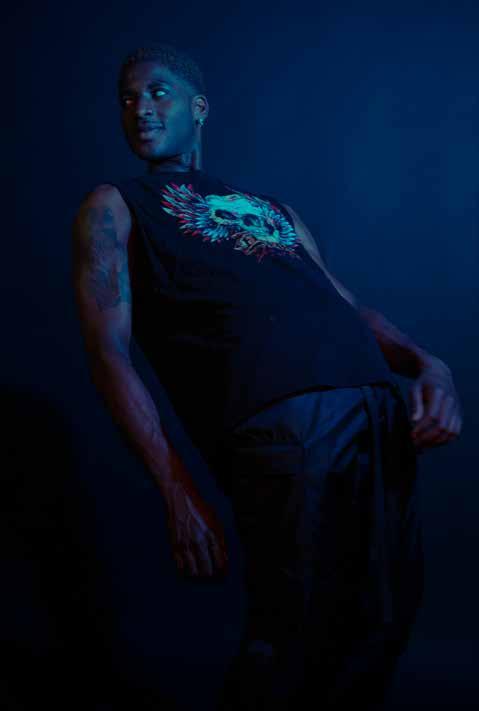
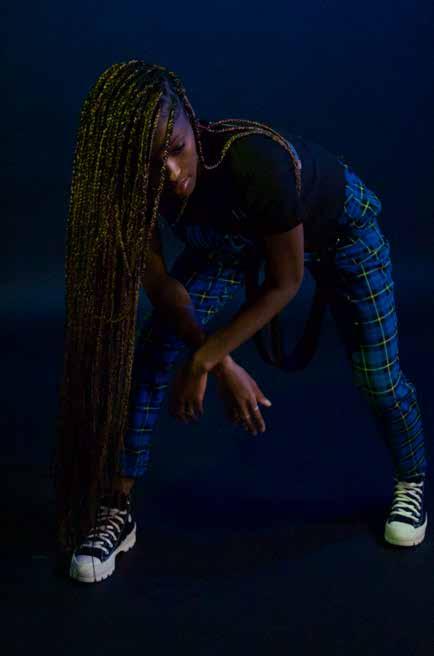
have now,” Noir said. “Being black is punk in itself.”
Others also note the lack of diversity and culture in the punk alternative scene, particularly in Columbia.
Ben Wright, a 22-year-old Columbia resident, observes that it has its challenges.
He finds that stereotypical African American culture can sometimes be closed off to other interests. “It can be extremely hard to try to find something new or to get out of your comfort zone and even admit to yourself that you like something,” Wright said.
However, Wright never let that stop him. “Probably when I was about twelve, I started finding music on my own. Nirvana was one of the first bands I ever listened to, and I just fell in love with the whole grunge and punk scene.”
His tastes have changed over time. When he was younger, he listened to artists like Fall Out Boy, The Cure and Tupac. In recent years, he’s delved into the works of Lenny Kravitz, Prince and The Black Pumas.
“I don’t want to clarify myself with one
genre, or style, of people,” Wright said. “But I’d like to say that it’s a little bit more on the alternative punk side.”
In terms of the alternative punk scene in Columbia, Wright believes that it most definitely exists. One of his favorite places is New Brooklyn Tavern, the oldest continuous running music venue in the area.
“They have a reputation for being probably one of the most punk places in Columbia because they’re well known,” Wright said. “They do their hardest to keep it clean and have a really good, friendly environment there.”
He has attended shows there since he was thirteen years old, and the venue has experienced changes over the years. One of his favorite performances at the venue was in 2016 by a local alternative band known as the Brigades.
“Everybody was having a good time,” Wright said. “People were moshing. I saw a kid get punched in the face. It was great.”
Wright also creates his own music. Ever
since learning the guitar, he’s wanted to tackle more personal subjects in his songs.
“Most artists, if you really listen closely, they’re talking about their own experiences or how they feel, or anything that they need to get off their chest,” Wright said. “It’s like therapy.”
Surprisingly, he pulls most of his inspirations from the genres of Indie, Neo-soul and R&B, as opposed to punk and alternative. However, it doesn’t mean he loves the genre any less. For those wanting to know more about Black people in the punk alternative scene, Wright recommends doing a deep dive into Afro-punk.

In recent years, the punk alternative scene has fostered a more accepting environment as people become more knowledgeable about the genre’s past.
“It’s become more of an accepting thing where people are going back to their roots,” Nori Noir said. “I can feel more comfortable with indulging in it too.”
DON’T YOU, FORGET ABOUT THEM: Addressing a Lack of Diversity in Iconic Films

Q: What do you remember about the first time you saw yourself represented on screen?
Aman: I started watching shows like Phineas and Ferb, you had Baljeet. And you had that other show Jesse. Jesse had Ravi. You know, we got the stereotypical, nerd Indian that’s like not cool and it’s kind of a dork with a thick accent. Yeah, it was...all the same, you know, thick accent, looks a certain way and just only good at books and stuff. That’s the representation.”
Justice: Well, growing up in an African American household. That’s mainly, you know, the type of media that we were exposed to. So different movies, such as Poetic Justice, Love, and Basketball were very popular in my home. So it wasn’t foreign to me to see people of color on film.
Nesreen: For me, I think, being Arab and Muslim, I always see representation of my culture as terrorists. That was the first time I’ve ever seen us be represented. So I feel like I’ve never seen myself represented as just like a normal person, there’s always such a negative connotation.
Chelsea: That’s a hard question because I grew up in Asia. Everyone there is like me. But coming here was the first time I was minority. That was definitely an adjustment to make I think. Nobody really tells you about it because I feel like it’s such a niche experience to have that, you don’t really move to whole other continent where you’re a minority
Q: How would you ideally like to see your community represented on screen?
Aman: I don’t want like a perfect character on screen, but, you know, it’s okay if you have an Indian in a movie, that’s not like Mr. Know it All. It’s like, you can’t have an Indian that’s like a douche bag or something, or you can’t have Indian that’s athletic? They don’t have to be the smart person in the group. They can be like anything else, right?
Q: Did you have anyone that you looked up to specifically media?
Justice: Not specifically, but honestly, I guess a turning point or monumental point for me, would be seeing the first black Disney princess. Yeah, represented in Disney films because, of course, there was representation for whites and even Asians, you know, but for us to have an actual Disney princess was very big for me, which is why she’s that’s one of my favorite princesses now.
WRITTEN AND STYLED BY PARKER BLACKBURN • PHOTOS BY CHLOE CAUDILL • DESIGN BY ALIZAJANE HICKS • MODELS: ASHER PARSON, AMAN SINGH, CHELSEA CHANG, NASREEN ALMOSADDER, JUSTICE KELLY AND RYAN ALBINO
Q: Does not being represented diminish, your dreams and ambitions?
Chelsea: You know, over time if anything I think it has helped me become more comfortable with who I am, more self-aware and confident - which I think is very lucky for me. I don’t think a lot of other people can say that.
Q: Does not being represented diminish, your dreams and ambitions?
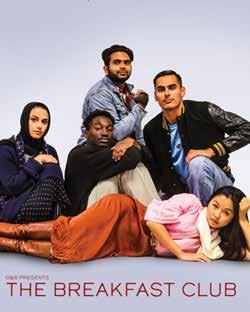
Ryan: I think overall for me it’s kind of hard not to be proud of being Latino because, you know, I’ve been told all these stories like from grandparents and from my dad and stuff about how hard it is, how hard the grind is, and living in a place like that. They talk about the land of opportunity and what not and I don’t think people realize sometimes how good we have it here. It’s a proud moment because like I do want to represent my family specifically, peruvians and what not. I guess like just trying to be successful in my own right.

Q: Did it have an effect on you to not be represented in media or to be overly stereotyped?
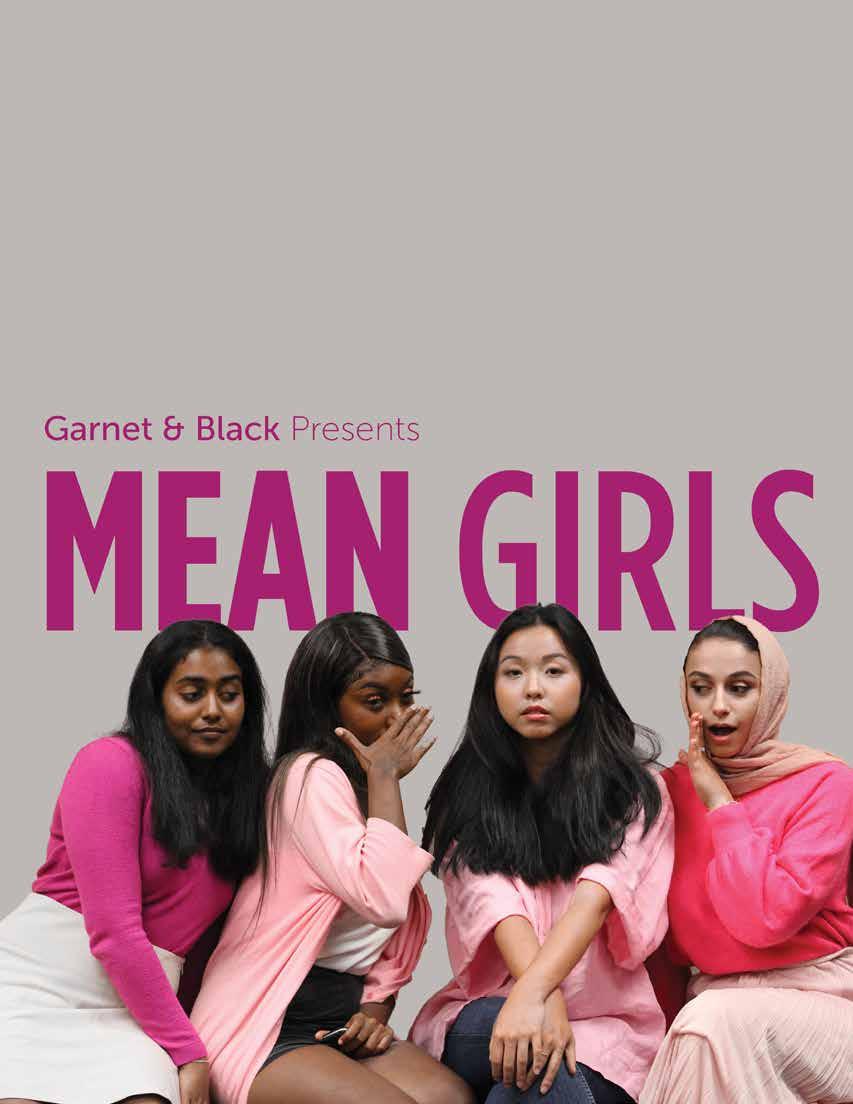
Asher: Yeah. Shit gets me every time. Like if I had a nickel for every person who would walk by me in street and give me a glance and instantly start walking farther away from me... That’s fucked up. That’s so fucked up.
Aman: I’m a photographer, I’m part of, like, leadership groups and stuff. I was part of the step team in high school, I play basketball. People don’t know that, and they just think [I’m] one dimensional.
Nesreen: I feel like it’s just really sad because now it’s just such a burden to me because I always feel like I have to represent my faith in a good way or people are just going to assume that what they see in media, and what they see in TV shows is true. So I feel like it’s just, it’s been a burden. Any woman with a scarf is always going to be the wife of a terrorist like you’re never going to just see a girl in a scarf. You know, I think on Netflix now I
see like background characters wear scarves. Like they’re not like in the movie for real, but if it’s a main character, it’s always going to be like in a negative light.
Q: Why do you think you aren’t being represented? If you are, do you think that your community is being represented correctly?
Justice: I definitely think African Americans are represented within media, but there’s a stereotype that surrounds it. You have the angle, oh my gosh, you know the Angry Black Woman character or you know, the thug or whatever, you know, so there are certain things that are represented well such as unity within the black community but there’s always stereotypes that portray us in a light that really isn’t us.
Ryan: I think in comparison to a lot of other Latin countries, I think Peru is definitely one of the lowest on the as far as our recognition goes. So I would say I think maybe we just get overshadowed by other countries
Nesreen: I think we aren’t being represented because of the stigma the media portrays. You were talking about princesses. There’s Princess Jasmine, but even then, there’s like, still negative connotations associated with that movie. When you look at the evil people in the movie, they all have darker, Middle-Eastern features, thick eyebrows and big noses. Those are common Arab features. But I think the main reason we’re not being represented is because of the stigma and stereotypes associated post 9/11. We just hope they’ll go away, but not yet. Also the people that are telling those stories [are] portraying Arab people in such negative ways. [They] don’t take the time to sit there and meet Arab people.
Chelsea: This is a hard question to answer because I don’t really know the Asian American Community here because I just moved here three and a half years ago. I’m seeing a little bit more representation but it’s always still plays into the stereotype a lot. It’s always that nerdy Asian, the sidekick. There’s always a specific role they’re trying to get us to fill that in no way represents the entire community.
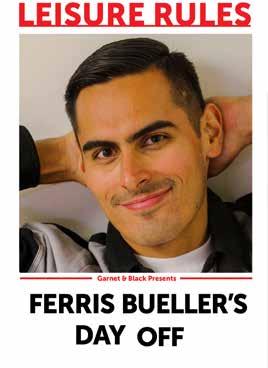




Q: What does representation in media do for you specifically, or what would it mean to you?


Ryan: I want to make it in my field and my profession – it’ll give me a platform and a great position to speak and be a leader amongst people. I’m the one to always, speak up and speak out about something. So, having that platform of the future would be really sweet because I’d be able to be able to speak for anyone who needs me.


Still
BY RIDHA FATIMA • ILLUSTRATION AND DESIGN BY CECILIA CALLOZZO
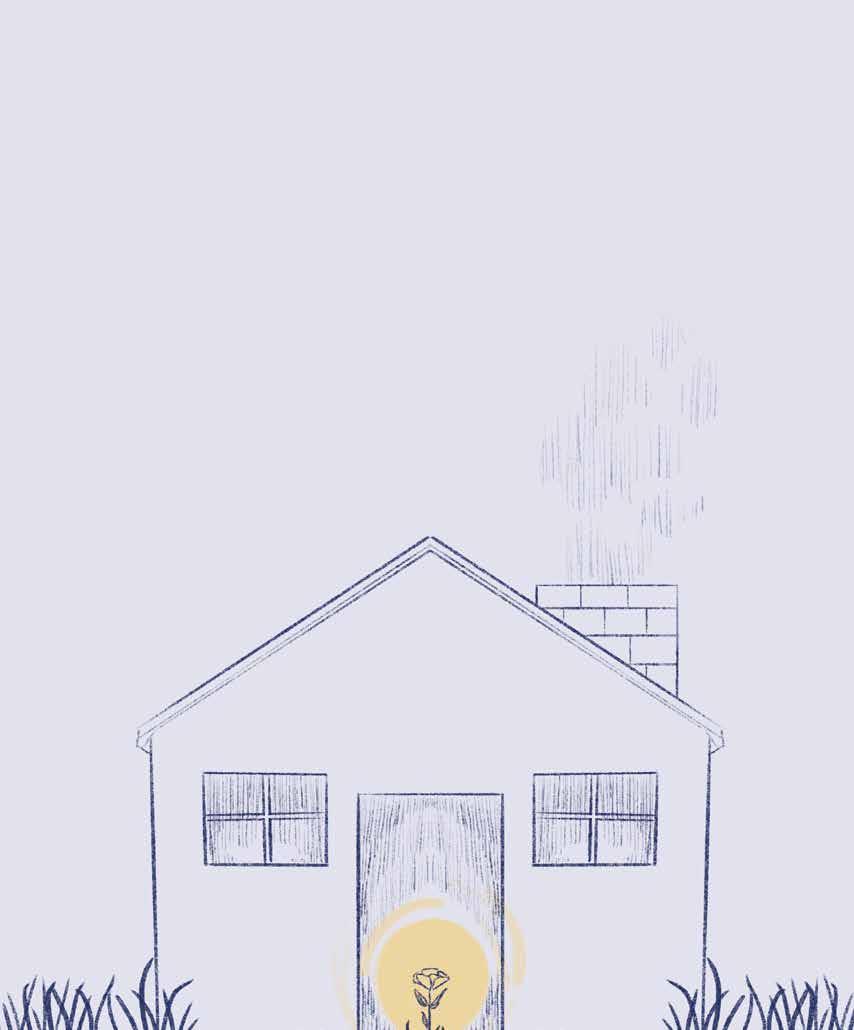
A room may look emptier without its furniture, but it will always be full of memories — of glow-in-the-dark stars still stuck to the ceiling, worn drapes forgotten on the floor, holes on the wall left over from posters first tacked all those years ago.
Even bare, this room holds more of you than anyplace else.
You want to strip the room of this essence, find the pieces of yourself you lost long ago, scraps shoved under the carpet or bathroom sink out of fear that some stranger would crush them with cruel hands.
You wonder how much of this you will forget; in a few years, you may come back and find that the carpet only covers the bare floor and the bathroom sink holds nothing but an empty soap dish, or that you’ve forgotten how you once decorated this place;
those scraps will all have been swept away by time, and you will become the stranger you were once afraid of.
Maybe that’s for the best, though; maybe it’s better to be the person that’s leaving instead of the one who’s left, the one stepping out of the door instead of the child sitting by the window, morning after morning, striving to see a sunrise that’s just out of view.
If you leave, you could finally see the Sun, see the way something begins its journey, Over and over again, without ever being stuck. You constantly ask yourself how long you may feel unwelcome in any new place you try calling home, how long before the idea of leaving won’t feel like a betrayal.
You used to ponder these questions before you went to bed, making constellations from your glow-in-thedark stars, hoping to find some type of meaning in this medley.
Now, you stare at blank walls, still looking for that answer, but you won’t find it here.

You won’t find yourself in the empty places that were once meant just for you, and you cannot hold so many pieces of the person you were when you already have so much to carry.
Even if you’re still unwilling to leave, this is the thought that pushes you out the door, arms full of boxes, shoulders weighed down by memories.

AUTUMN LEAVES FALLING DOWN LIKE PIECES INTO PLACE A fall playlist made for you by our social media team Scan here for the full playlist: DESIGN BY MARIA DESIMONE All Too Well Taylor Swift Love All (feat. JAY-Z) Drake 505 Arctic Monkeys Cheer Up, My Brother HNNY Magic Coldplay Jump Mac Miller Take Me Out Franz Ferdinand Proud Of U (feat. Young Thug) EARTHGANG Enjoy Right Now, Today Tyler, The Creator Outta Luck Bull Street Garage Apply today to become a Feonix Volunteer Driver volunteerdriver.org | 1-833-653-6544 Without transportation, our neighbors have to go without essentials like health care, medication, and nutrition. Our Feonix Volunteer Drivers make a difference in the lives of seniors, veterans, and anyone in need by connecting them with vital services that support their well-being. VOLUNTEER TODAY!
SOCIAL MEDIA SOCIAL MEDIA SOCIAL MEDIA SOC
FOLLOW OUR TIKTOK @GANDBMAG



@scrub.mattie
Curiosity Coffee Bar’s cold brew with oat milk.
@nathunt12
Iced Matcha from Cool Beans.
@a.leach
Honey and oat lattes from Cool Beans.
@_parkerpaige_
Monkey around or Baklava latte from Curiosity Coffee Bar.
@camrynteder
Oat milt lavender latte.
@itsjustjazlynn
French Vanilla Iced coffee with creamer and almond milk.
@hannahgraceburroughs
Iced chai with 3 pumps of pumpkin.
@annaottinger
Oat milk dirty chai with pumpkin cold foam.
@lily2214
Iced coffee with oat milk and cinnamon on top.
@abigailmonegan
Green tea.
@anna_anspach
Pumpkin cream cold brew.
@trisgogol
Honey lavender from cool beans.
@carolinecallicutt
Chamberlaincoffee
@clara.bee.bergeson
Iced honey vanilla oat milk latte from Drip.
THIS OR THAT?
37% 63% Leggings Jeans
Flannel Jean Jacket
64% 36%
Turtle neck Blazer
70% 30%
Ankle Boots Combat Boots
41% 59%
Chunky Sweater Cardigan
78% 22%
COMMUNITY CAFFEINE
DESIGN BY GRACE NEGRON
Overheard at UofSC
BY ADDISON HINKLE • DESIGN BY MEGAN WOOTERS
“It’s a fine line between self care and destructive habits and I walk it everyday."
“I’ll grab you with my sweaty palms all night."
“My computer isn’t charged so I’m kind of useless.”
"You're a klepto. I love you."
"I live in YouUnion so that's pretty far."
"Maybe get better at getting what you want."
“Your girlfriend was in my class.” “Which one?”
"Your gonna try Acid?"
"Yeah that's my favorite song."
"Wake me up when my pizza comes."
“He’s an Eagle Scout, so he can tie you up really good.”
"He called me big mama. I think he's trying to hook up."
"My professor just bumped me from an F to a B and I didn't even have to sleep with him."
"I just peed myself a little."
"Nothings better than drinking on a Wednesday."
"I can't believe I have a hickey from a guy that's shorter than me."
"I wanna save my ID for my kids cause I think we're gonna look alike."
C L O S E T O C A M P U S , J U S T O F F T H E R I V E R






E n j o y t h e b e s t o f W e s t C o l u m b i a w i t h a n a p a r t m e n t n e a r U S C l o c a t e d i n t h e R i v e r D i s t r i c t a n d o n l y a s h o r t d i s t a n c e f r o m c l a s s e s R e d t a i l o n t h e R i v e r i s a b e a u t i f u l s t u d e n t h o u s i n g c o m m u n i t y t h a t f e a t u r e s u p d a t e d a p a r t m e n t i n t e r i o r s p l u s e n g a g i n g c o m m u n i t y a m e n i t i e s l i k e p r o f e s s i o n a l b a r b e c u e g r i l l s , a s w i m m i n g p o o l , a n d s p o r t c o u r t s W i t h a 2 4 - h o u r b u s i n e s s c e n t e r o n s i t e , s h u t t l e s t o t h e U n i v e r s i t y o f S o u t h C a r o l i n a , a n d c o n v e n i e n t a c c e s s t o m e t r o l i n e s a n d n e a r b y c o l l e g e s , t h i s i s t h e p e r f e c t p l a c e f o r U S C s t u d e n t s R e d t a i l o n t h e R i v e r ’ s s t u d e n t a p a r t m e n t s i n W e s t C o l u m b i a , S C w e r e d e s i g n e d t o h e l p G a m e c o c k s t u d e n t s s u c c e e d a n d d e d i c a t e d t o h e l p i n g t h e m f e e l a t h o m e



N O W L E A S I N G F A L L 2 0 2 2
W A I V E D F E E S & R A T E S A S L O W A S $ 6 7 5





C A L L T O D A Y | 8 0 3 . 9 3 7 . 2 4 1 3










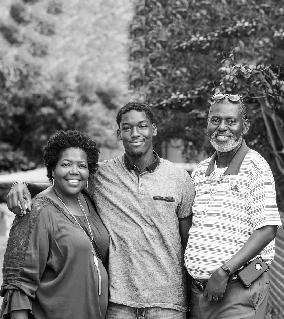

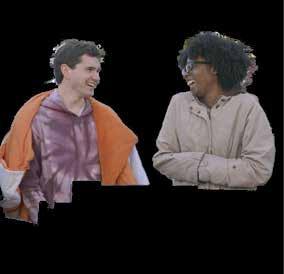









@uofsclife www.sa.sc.edu/stlife/



































 BY KELLY HUGHES• DESIGN BY OLIVIA SON
BY KELLY HUGHES• DESIGN BY OLIVIA SON


















 LAUREN JAMES • PHOTOS BY LEXI CROFT • DESIGN BY MELISSA BORGERDING • STYLE COORDINATION BY CAT HARRIS • SNAPCHAT FILTER MADE BY JULIA DUNNE
LAUREN JAMES • PHOTOS BY LEXI CROFT • DESIGN BY MELISSA BORGERDING • STYLE COORDINATION BY CAT HARRIS • SNAPCHAT FILTER MADE BY JULIA DUNNE















































 Academia Wear
Academia Wear
 PHOTOS BY ABBY DETORIE AND DEV PATEL • DESIGN BY JULIA DUNNE • MODELED BY BAILEY ZIPP AND JA’LENE JAE’KIAH WOODS • STYLE BY CAROLINE CALLICUTT
PHOTOS BY ABBY DETORIE AND DEV PATEL • DESIGN BY JULIA DUNNE • MODELED BY BAILEY ZIPP AND JA’LENE JAE’KIAH WOODS • STYLE BY CAROLINE CALLICUTT









 Leather dress: Vestique
Trousers: Vestique
Leather dress: Vestique
Trousers: Vestique


 BY CARSON PEADEN • PHOTOS BY FREDERICK GAUSE AND SHAIRA NIXON • DESIGN BY SHAIRA NIXON • STYLED BY TONI DELOACH • MODELED BY: DEVIN WILLIAMS, AMBER GLOVER AND ZAMANI LYDE
BY CARSON PEADEN • PHOTOS BY FREDERICK GAUSE AND SHAIRA NIXON • DESIGN BY SHAIRA NIXON • STYLED BY TONI DELOACH • MODELED BY: DEVIN WILLIAMS, AMBER GLOVER AND ZAMANI LYDE




















































